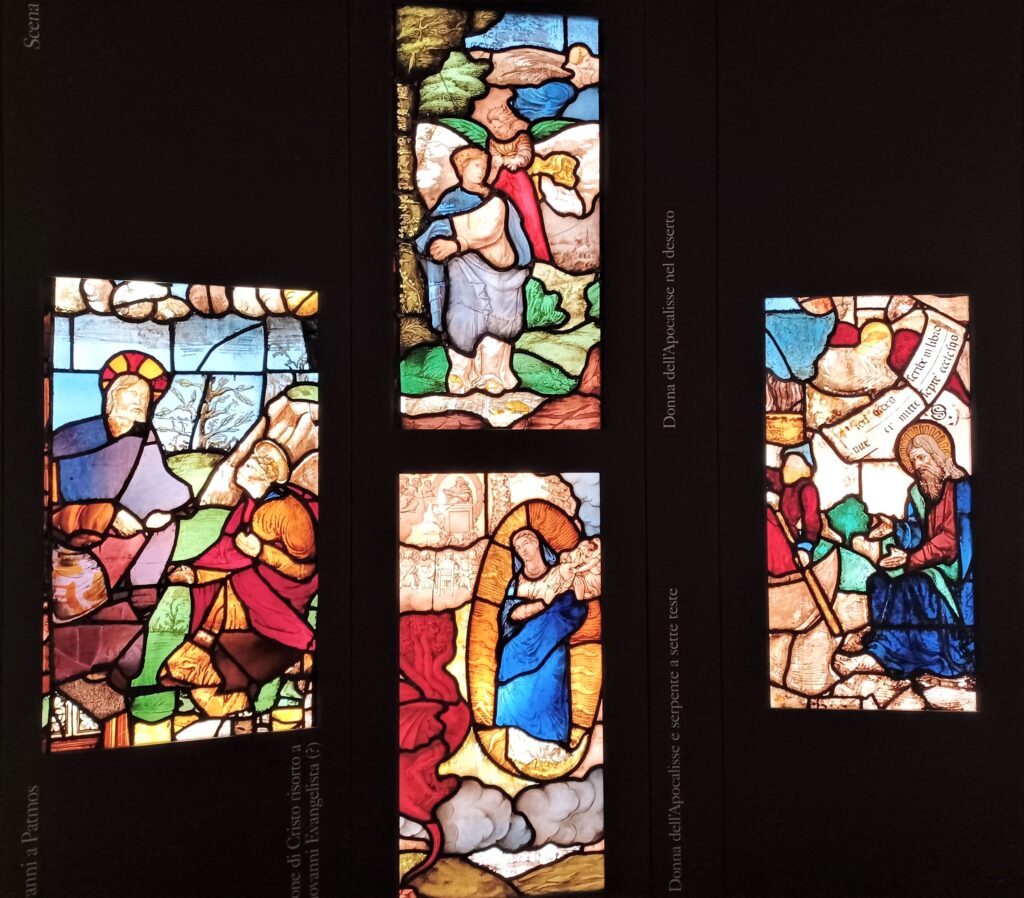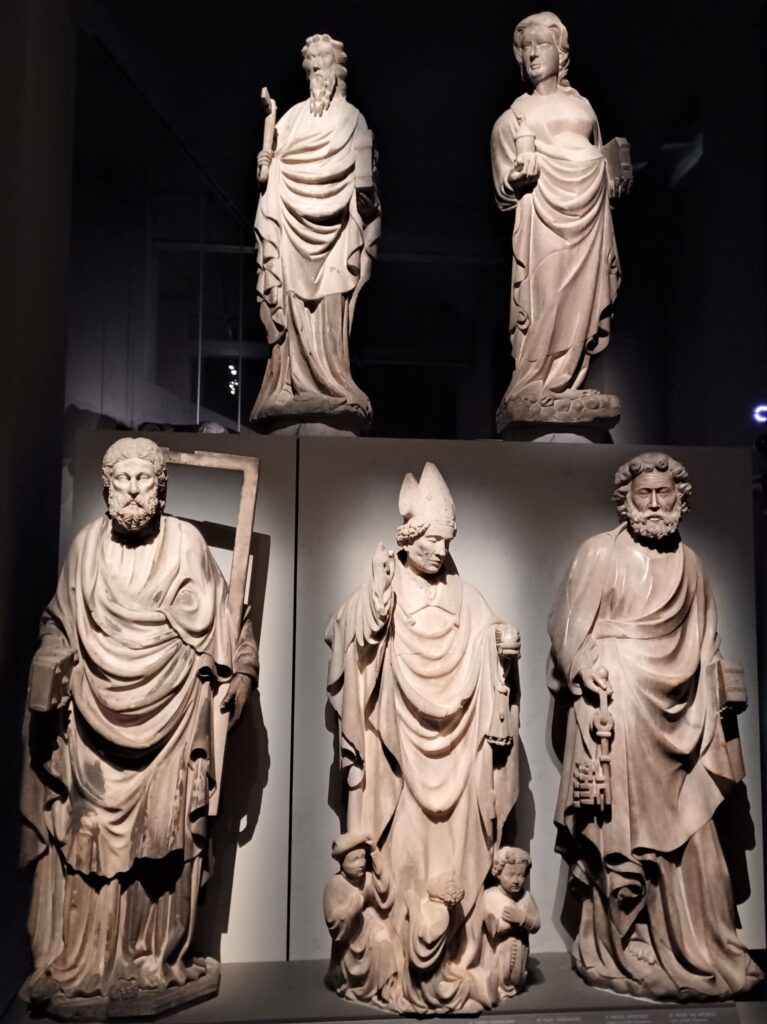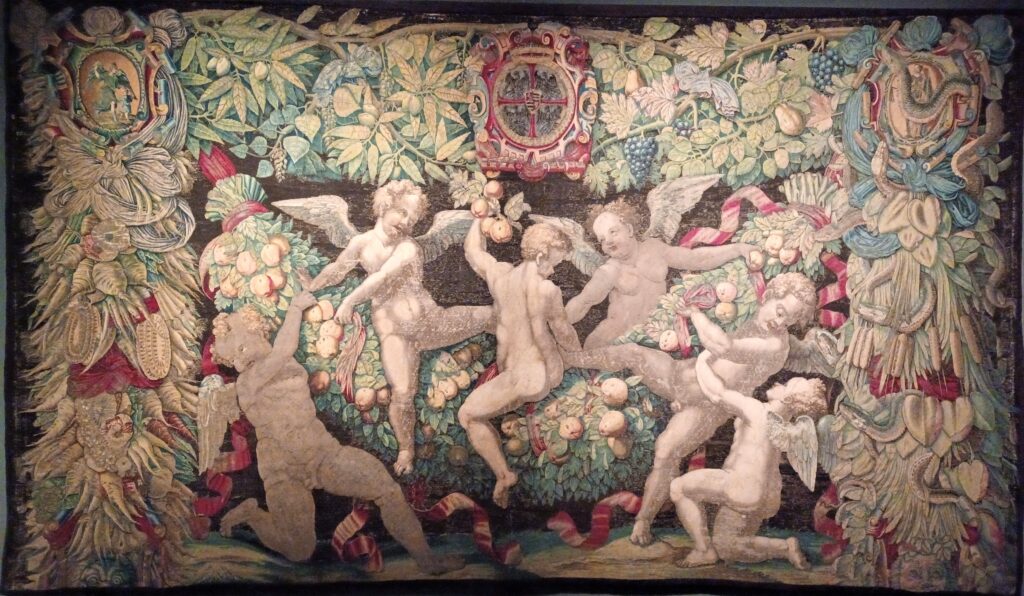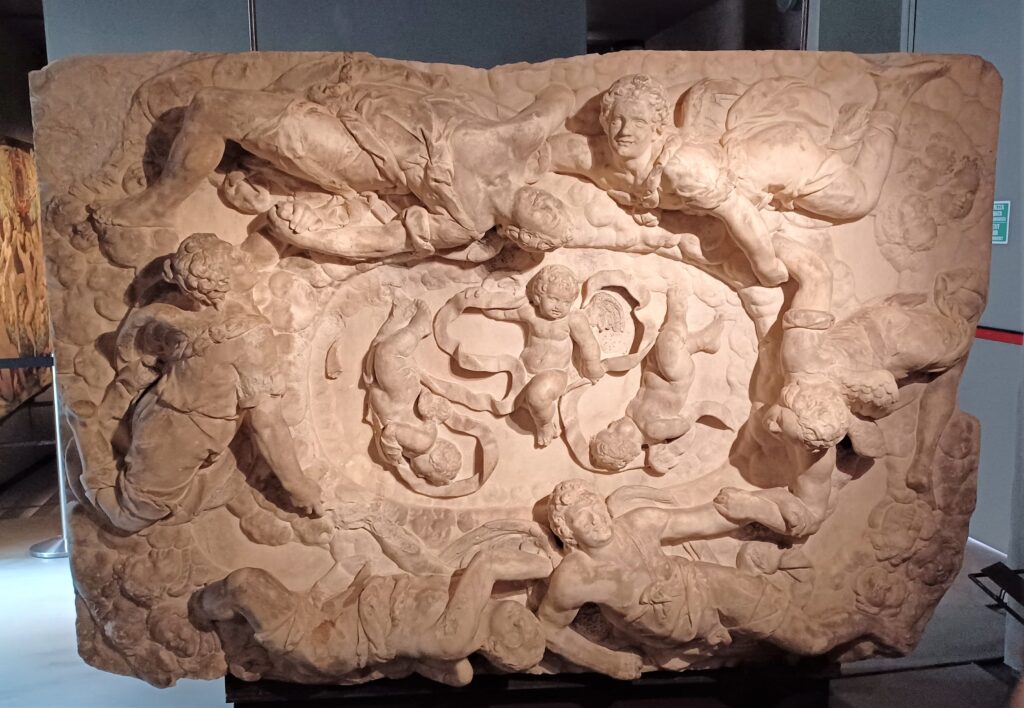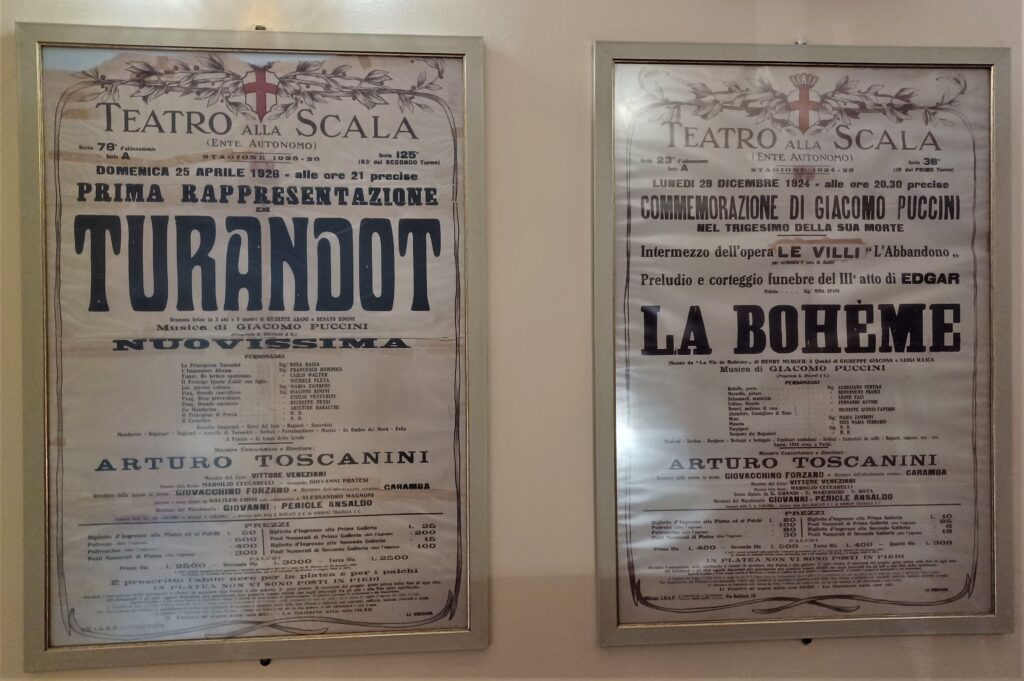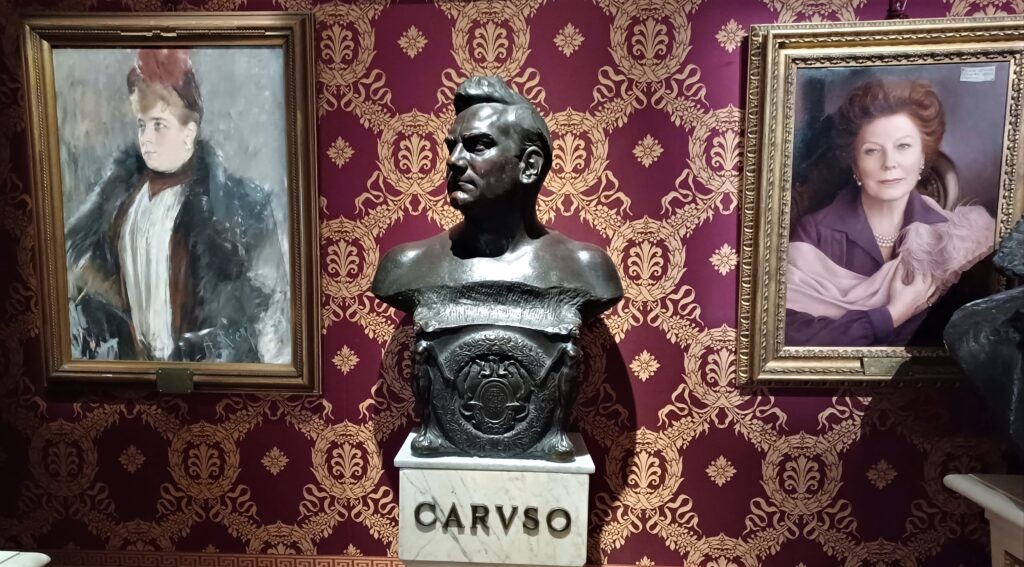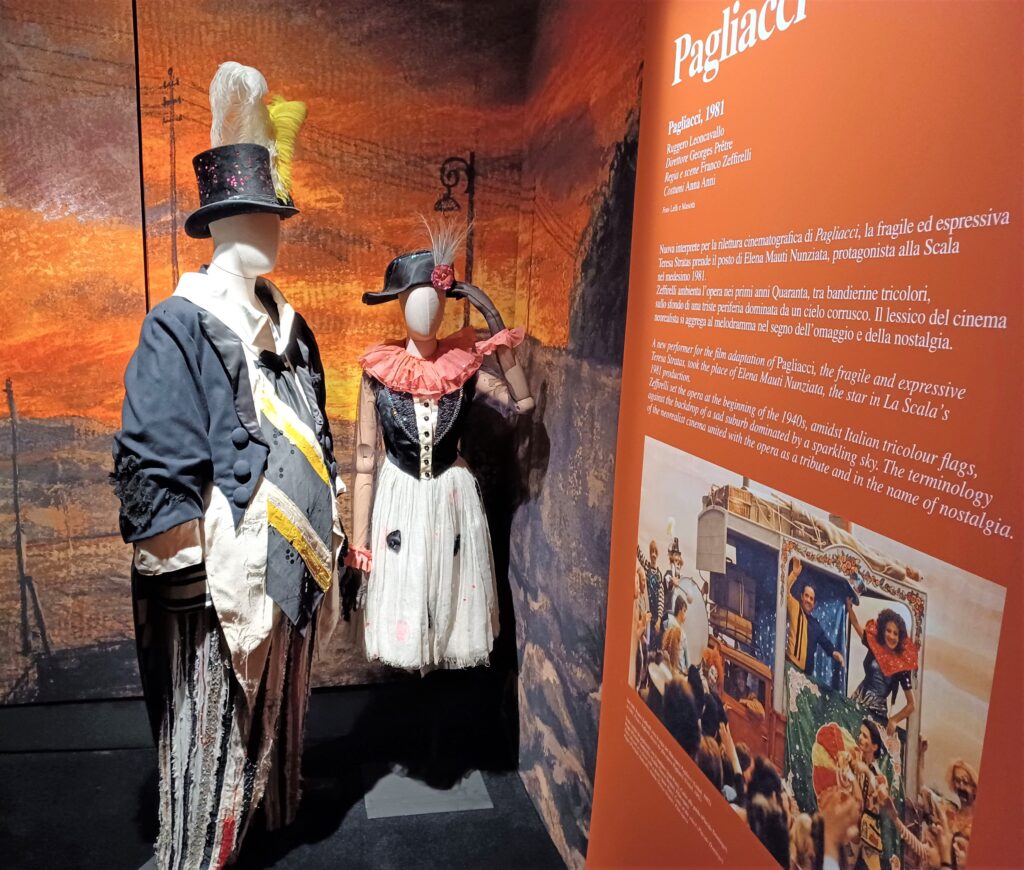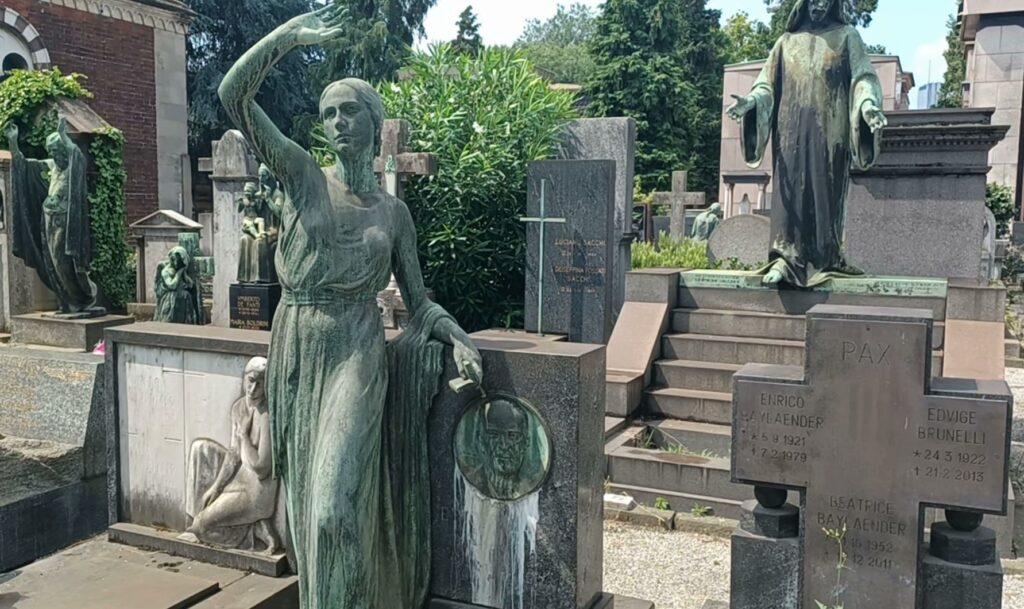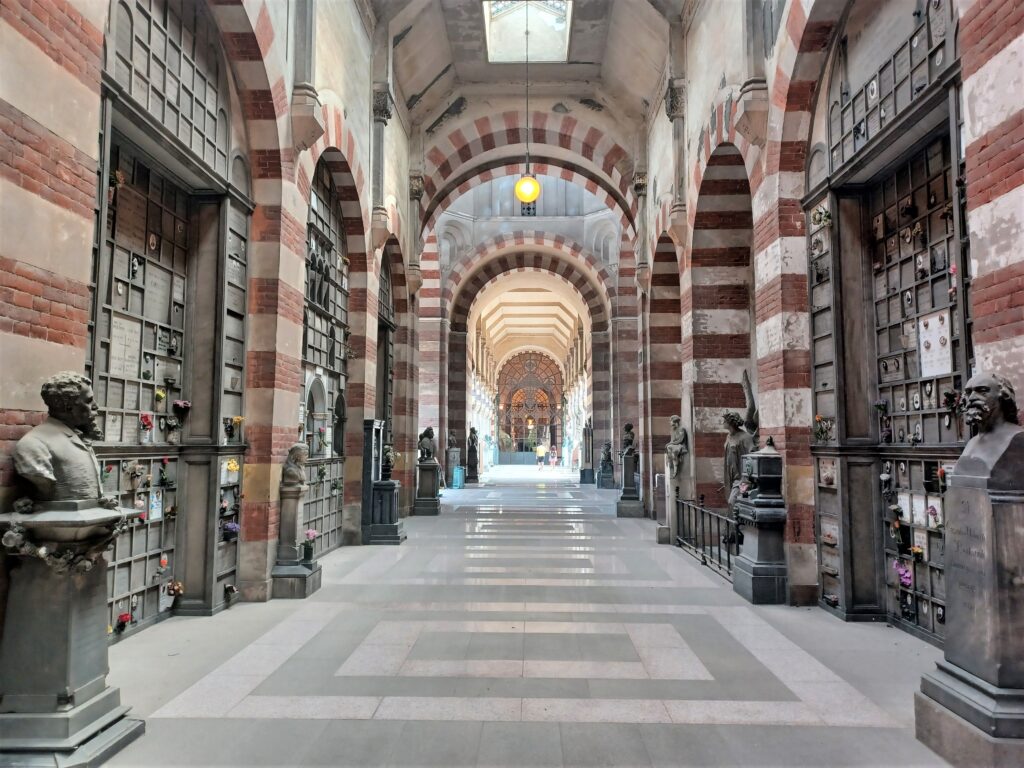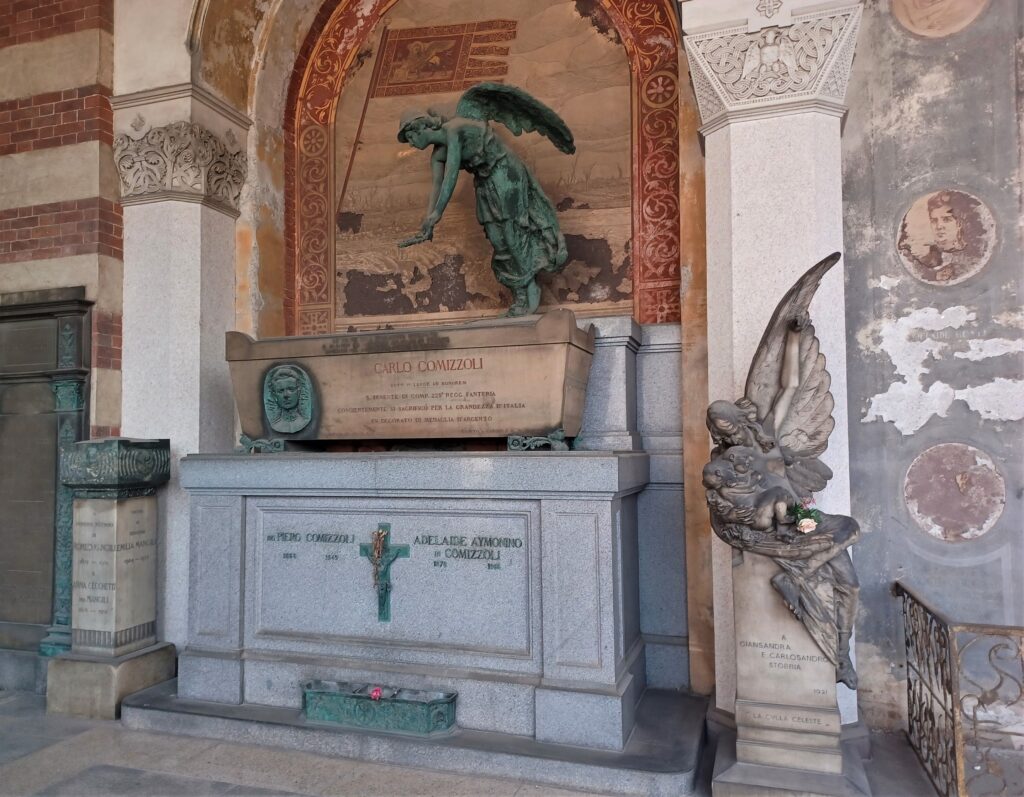Known as a fashion capital and financial center, Milan also has a vibrant food scene made all that much better with its international flair enhanced by several lively immigrant communities.
A Short History
Some of the earliest archaeological records are from the Camunni people who were in Lombardy perhaps as long as 12,000 years ago. Etruscans were later active in the area.
Milan’s history of settlement can be traced to 400 BCE when it was occupied by the Gaul/Celtic Insubres people. The Romans conquered the city in 222 BCE and made it the capital of the western Roman Empire in the late 2nd century CE.
Charlemagne’s army took the city in 774 and during the Middle Ages Milan was ruled alternatively between the Guelphs and the Ghibellines.
In 1395, Milan became a Duchy and shortly thereafter the Ambrosian Republic was established. The Republic was defeated by Francesco Sforza and the house of Sforza 1450. Francesco ordered reconstruction and expansion of the local fortification and dubbed it the Sforza Castle. House of Sforza was a great patron of the arts and Milan became a leader in the Renaissance movement, especially when Leonardo da Vinci moved to Milan to work on “The Last Supper” and other works. When the French defeated Sforza and took over Milan, Leonardo fled to Venice.
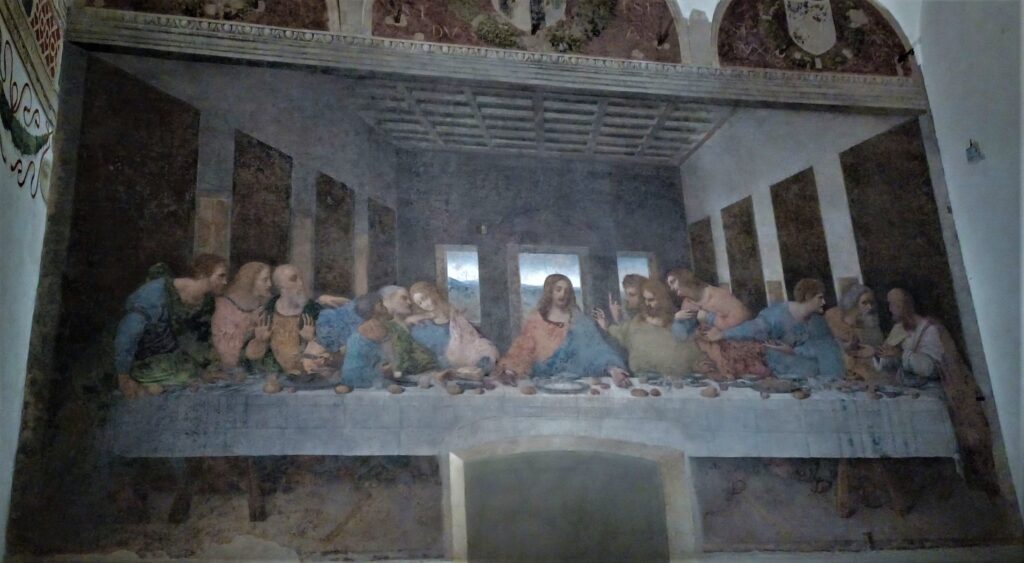
In 1629, a plague killed half the population of Milan.
Napoleon invaded and conquered Milan in 1796, naming the city capital of the Kingdom of Italy. When Napoleon was defeated, Milan and the rest of Lombardy was granted to Austrians. It was during this time that opera came to the cultural forefront and La Scala opera house became a center the music culture.
The Austrians weren’t ousted until 1859 with the help of France and Sardinia, Shortly afterwards, Italy was united as a single entity in 1861.
After WWI, Benito Mussolini began forming the para-military wing of what would be the Italian fascists in Milan. Mussolini’s crazed ideology of nationalism, colonization, and, by extension, racism, ended up dragging Italy into a ruinous WWII during which Milan was bombed extensively. The Italian resistance finally liberated the city in the spring of 1945. Mussolini and his mistress were captured trying to flee north to Switzerland and were executed on April 28th. The next day their bodies were transported to Milan where they were dumped in Piazzale Loreto. Furious Italians kicked and spat upon his corpse which was then hung upside down from the roof of a gas station.
In the 1950’s and 60’s Italy experienced the “economic miracle” of growth and prosperity. Milan was a big part of this as a building boom and banking made the city rich. Later, in the 1980’s, Milan became a worldwide center of the fashion industry.
Foodie Milan
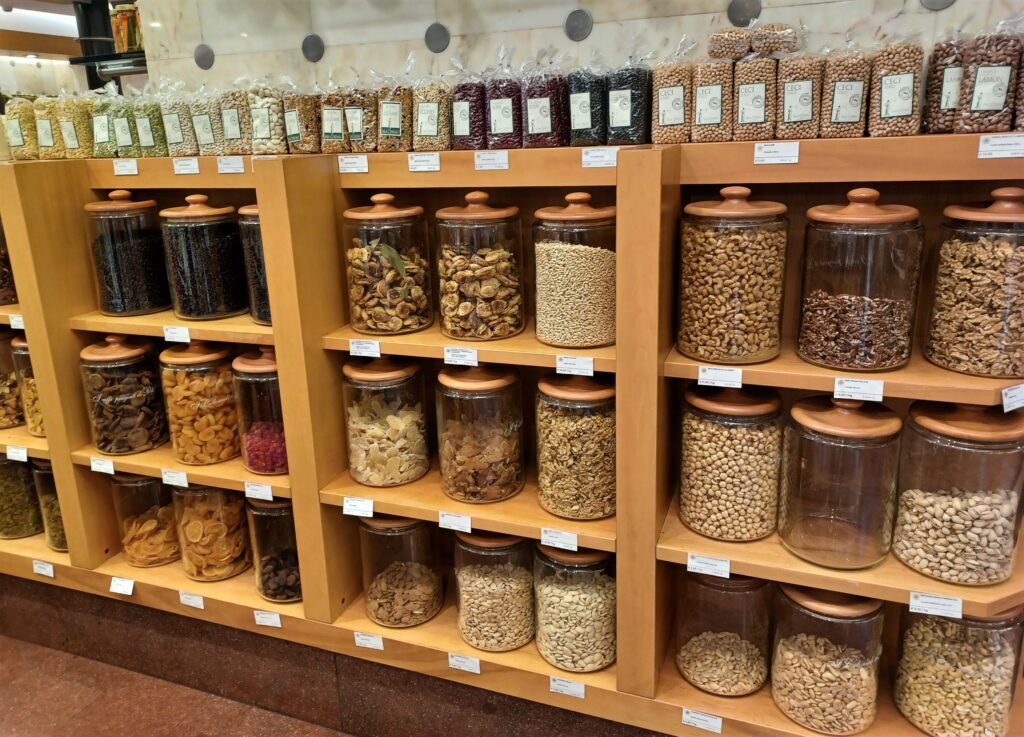
At first, Milan is a bit difficult to understand. When traveling to Italy, I’m always looking for that regional dish, that local specialty, that unique pastry that defines a place. While Milan claims Panettone, Risotto, and Gorgonzola, these dishes aren’t as celebrated as other local fare in other parts of the peninsula.
Instead, Milan is like New York, albeit on a much smaller scale. Both cities are financial centers and home to a robust fashion industry. And, the job market attracts people from all over the country and all over the world. This results in a food scene rich in cuisine from places usually not found in Italy.
International Food
Milan is an international city like New York or London. Workers from all over the world flock here for economic opportunities, many of which lie in the fashion and banking industries. Of course, not everyone is a financier or supermodel (though you do see plenty of them) as most folks work everyday jobs
Chinese cuisine
Milan’s Chinatown is the oldest and largest in Italy. Originally, immigrants came from Zhejiang province to work in the textile and leather industries. Today, Chinatown is lined with restaurants and little takeout kitchens with counters that are barely large enough for two people at one time.
Bon Wei is a high end restaurant with Michelin Guide recognition and a menu of dishes from 8 gastronomy regions in China.
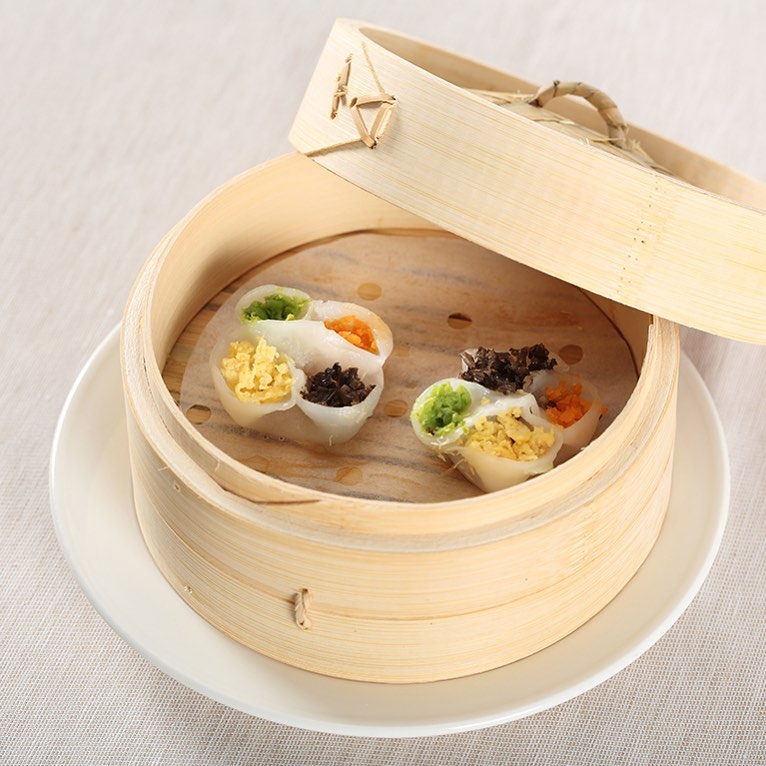
Outside Chinatown and not far from the Centrale Station is MU Dimsum. Not only do they have excellent Dim Sum, but they also serve a nice Bao, a fluffy steamed bun filled with duck egg cream.
Eritrean cuisine
In the late 1800’s, Italy colonized Eritrea in the Horn of Africa, taking land for their agricultural use. Italy also built an extensive railway project to move food to the Eritrean port and export to the peninsula. Many Eritreans “enlisted” in the Italian army and subsequently fought and died in Italian colonial wars. During the Fascist period, racist laws prevented Eritreans from advancing economically and politically and they were relegated to menial jobs.
In 1941, the British defeated the Italians and took over as colonial overlords in Eritrea. However, Migration to Italy didn’t begin in earnest until the Eritrean War of Independence (1961-1991). Milan is home to the second largest population of Eritreans in Italy after Rome.
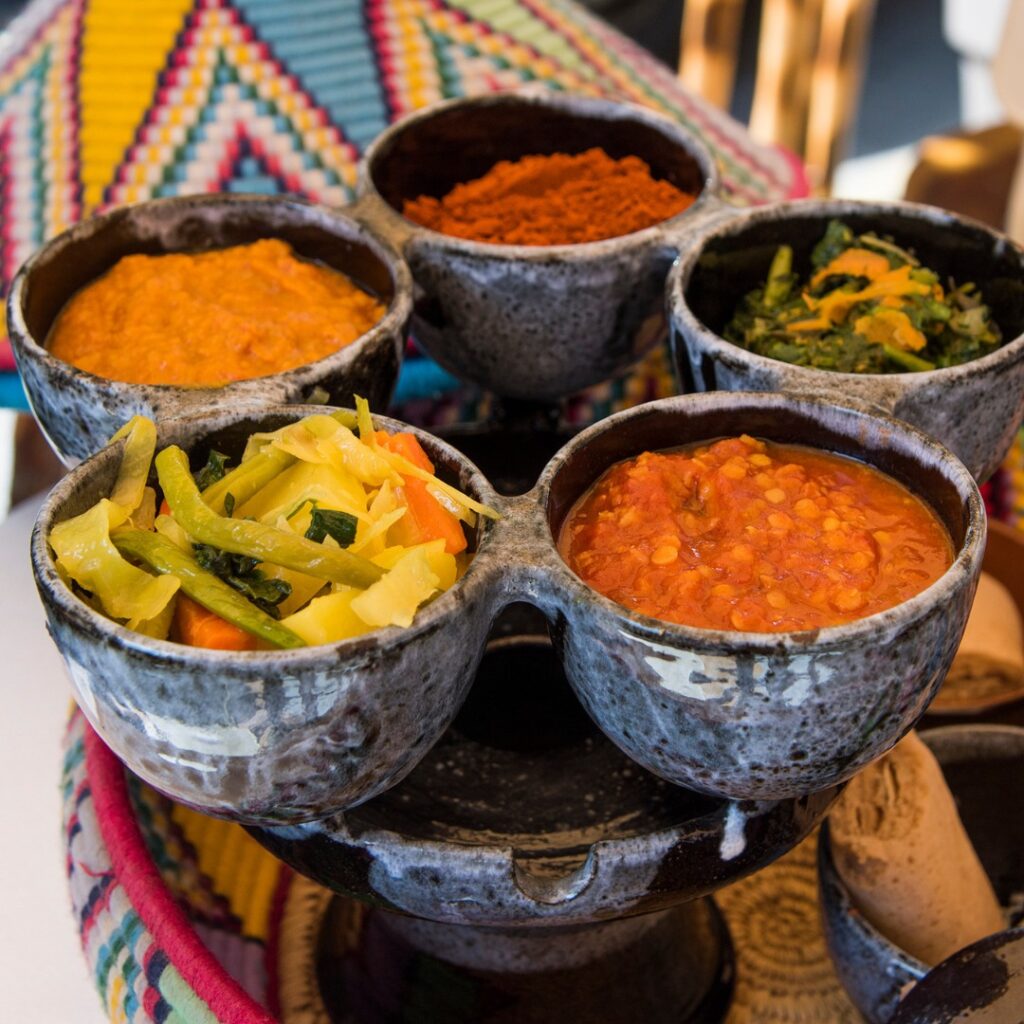
Warsa Restaurant in the Porta Venezia neighborhood serves traditional Eritrean food. Zighinì with Injera, the national dish of Eritrea, a crepe-like bread made with rice and corn flour is filled with vegetables, herbs, and beef or chicken. Vegetarians will be happy at Warsa because they make a Zighinì with potatoes, red lentils, couscous and other veggies. For dessert, Halawa, a delicious sesame treat.
Filipino cuisne
Migration from the Philippines to Italy began in the 1970’s. Unlike Hawaii, where many Filipino workers were men working in the sugarcane and pineapple fields, In Italy the majority of Filipinos were women who came to work domestic jobs. This is still true today, but now there is a second and third generation of Filipinos living in Italy who are trying to climb the economic ladder.
Unfortunately, most of the Filipino restaurants in Milan are of the fast food fried chicken variety. Or, they offer a Japanized version of Filipino food.
Masu, is a good choice. Their fried tofu with pakchoi and a balsamic reduction is very nice.
Panettone
Panettone, meaning large bread, is credited as a Milanese invention. In the early 20th century, two bakers from Milan started producing Panettone and shipping it around Italy. But, it was Angelo Motta who created the modern Panettone with its dome shape. He also revolutionized the preparation method of the sweet bread by doing three yeast rises. Motta also created an Easter bread called Colomba di Pasqua which uses Panettone yeast but contains less fruit.
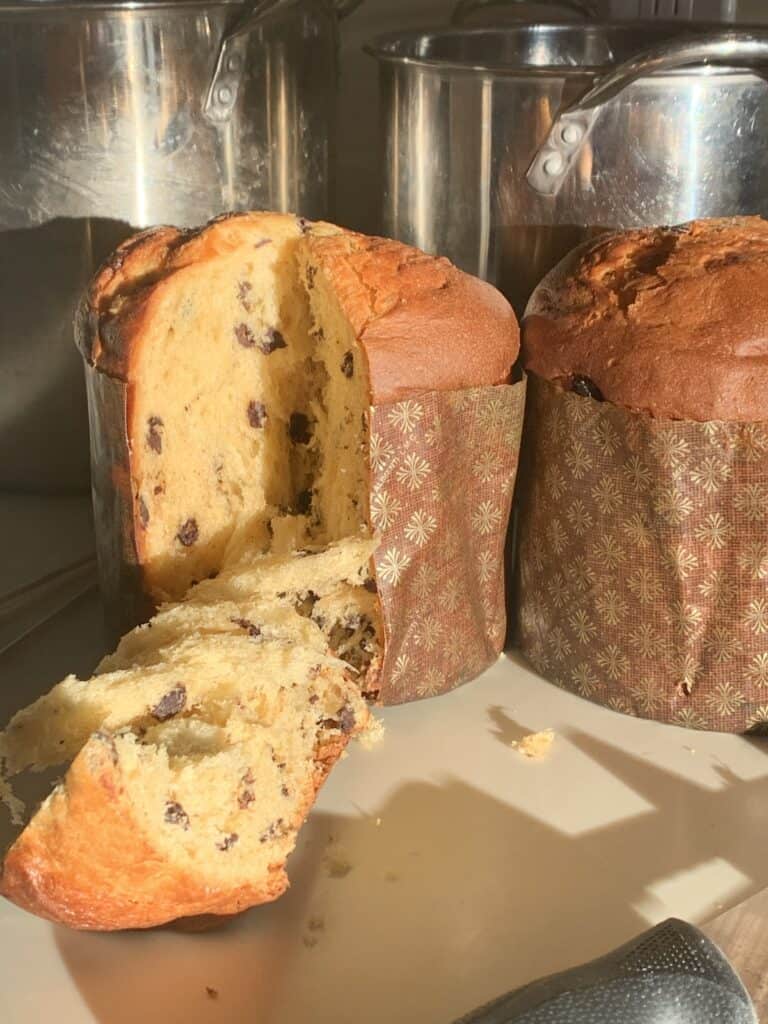
Motta’s company is now owned by Bauli an Italian company in Verona. Panettone is a classic Christmas gift around the world. It’s often given to workers in Italy at Christmastime.
In an effort to expand sales, Panettone is now available year round. You’ll find it in gourmet food shops all over Milan.
Some bakeries make their own artisan Panettone, using their recipes and changing up the candied fruit for fun taste variations. Better than the industrially produced Panettone, the treat can be pretty pricey, costing over €40 for a one kilo (2.2 pounds) loaf. Not to mention, how are you going to wolf down 2 pounds of sweet bread on vacation?
Luckily, there are some great places that sell Panettone by the slice. A perfect pairing with your espresso. Both Marchesi 1824 and Pavé are excellent choices. Best of all, they sell Panettone all year round!
Risotto
Risotto originated in the Lombardy region over 200 years ago so Milan claims it as her own. To make Risotto, short grain rice, like Aborio, is toasted in a pan along with sautéed onion and butter (or sometimes olive oil). Then, white wine is added, which is quickly absorbed by the grains of rice.
The next step is to add a stock (meat or vegetable or, frugally, water) one cup at a time while constantly stirring to release the rice’s starch and give the Risotto its creamy texture.
Finally, the Risotto is removed from the heat and Parmesan Cheese and butter is added. Ground pepper finishes the dish. Good Risotto should be slightly soupy and the grains should be al dente.
A few notes about Risotto. You’ll often see a dish advertised as something like Risotto alla Milanese con Zafferano or Risotto allo Zafferano. This dish is Risotto made with Saffron. However, Saffron is an extremely expensive ingredient. Oftentimes, Turmeric is added to the dish to give it the distinctive golden Saffron color. Buyer beware!
Also, vegetarians should note that the stock used in Risotto is traditionally a bone marrow stock. Many restaurants will accommodate your request for a vegetarian broth if you let them know a day or two in advance. It’s always best to ask. Sardinian restaurant L’Isola del Tesoro makes their Risotto vegetarian and Veganfruttariano – Sound of ’70s makes a vegan Risotto.
Gelato
Milan is one of the best cities in all of Italy for Gelato. It rivals even Florence for the number of high quality gelaterias. Artisan makers create classic flavors and new tastes using fresh ingredients.
Stracciatella, one of the most flavors of gelato originated in the city of Bergamo, not far from Milan. In 1961, gelato maker Enrico Panattoni, owner of restaurante La Marianna got the idea for a Stracciatella gelato when his customers kept asking for a soup called Stracciatella which is made by incorporating strands of eggs into a broth.
Panattoni’s Stracciatella Gelato was made using a similar method. He drizzled melted chocolate into plain Fior di Latte Gelato near the end of the churning process. The chocolate would freeze immediately and the paddles of the machine would break it up into strands.
Today, Stracciatella is one of the most popular Gelato flavors in Italy.
There are literally dozens of world-class gelato shops in Milan. I’ve listed a bunch below in the Index of Food & Drink in Milan. I’ll mention a few of the best of the best here.

Gelateria Paganelli has been around since the 1930’s. The shop is in a residential neighborhood so it doesn’t get as crowded as some other places, but don’t be fooled, Paganelli is the real deal. They often have some unique flavors and their Stracciatella is amazing. But, for my money, the Pistacchio Gelato is some of the best on the planet.

One of the best located gelato spots in Milan is Antica Gelateria Sartori. They’re right outside the Milano Centrale train station in a cheerful little trailer. Nothing better after a long train ride or bus ride from the airport (buses from the airport drop you at Centrale). They’ve been around since 1937 and their gelato is tremendous. Plus, they’re open late.
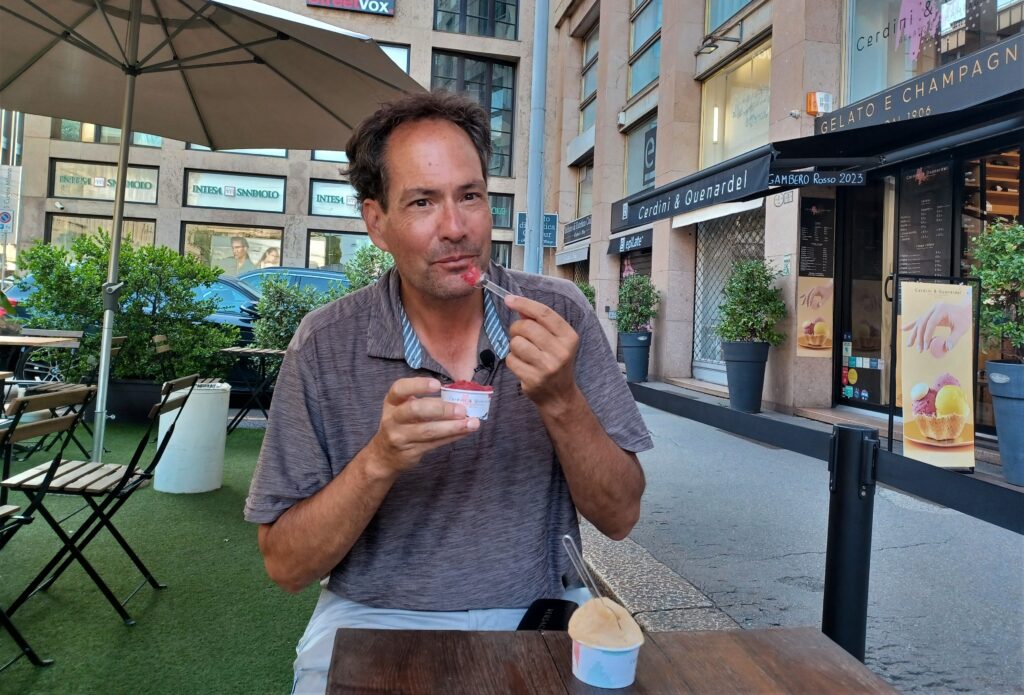
Cerdini & Quenardei dal 1906 has a unique take on Gelato, or, should I say, Sorbetto. Several of their flavors use Champagne as their base (Sorbetto is normally water based rather than milk based). The fresh fruit Pear Sorbetto is delicious, but the Plum Sorbetto is absolutely life changing.
Gogonzola
The town of Gorgonzola is about 40 minutes from Milan. This is where famous blue veined cheese supposedly was invented. According to the legend, a cheesemaker from Gorgonzola left cheese curds in an open vat and forgot about them. Later, he tried to fix his mistake by adding more curds to the vat. Returning months later, he found the characteristic blue cheese to be delicious and a whole new form of cheesemaking was created.
Gorgonzola is a PDO (Protected Designation of Origin) meaning that only blue cheese produced in the Lombardy and Piedmont regions of Italy can be called Gorgonzola in the EU. However, there are no such laws in the U.S. so there’s lot of Gorgonzola floating around that was made elsewhere.
Of course, there’s lots of other blue cheeses around the world like Roquefort and Stilton, too.
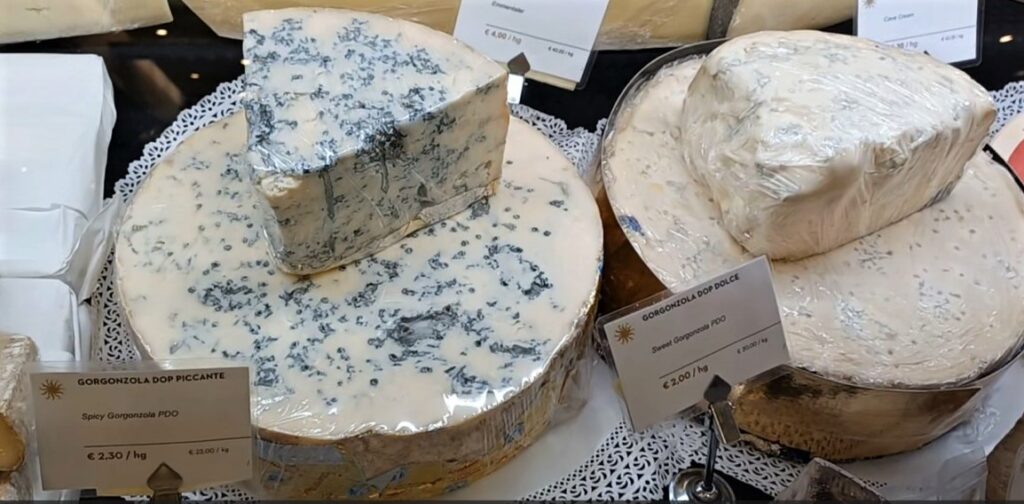
La Baita del Formaggio is a great cheese shop with a good selection of Gorgonzola. Peck is another option with their excellent cheese department.
Cannonocini
Cannonocini, aka Cream Horns, are similar to Cannoli. Sweet pastry tubes are filled with a creamy filling. In the case of Cannoli, it’s fried pastry dough that is filled with sweet ricotta cheese. Cannonocini, on the other hand, is a puff pastry filled with custard (sometimes whipped cream). And, unlike the Cannoli, the Cannonocini shell is only open on one end, thus the horn name. Panarello offers a very nice Cannonocini.
Mercato Centrale Milano (Food Hall)
Inside the Milano Centrale (the massive rail station is also the busiest in Europe) is a equally impressive food hall. Food stalls and popups offer expected dishes like pizza, pasta, and gelato. But, there’s also sushi, Chinese dumplings, and a BBQ joint from American chef Joe Bastianich.
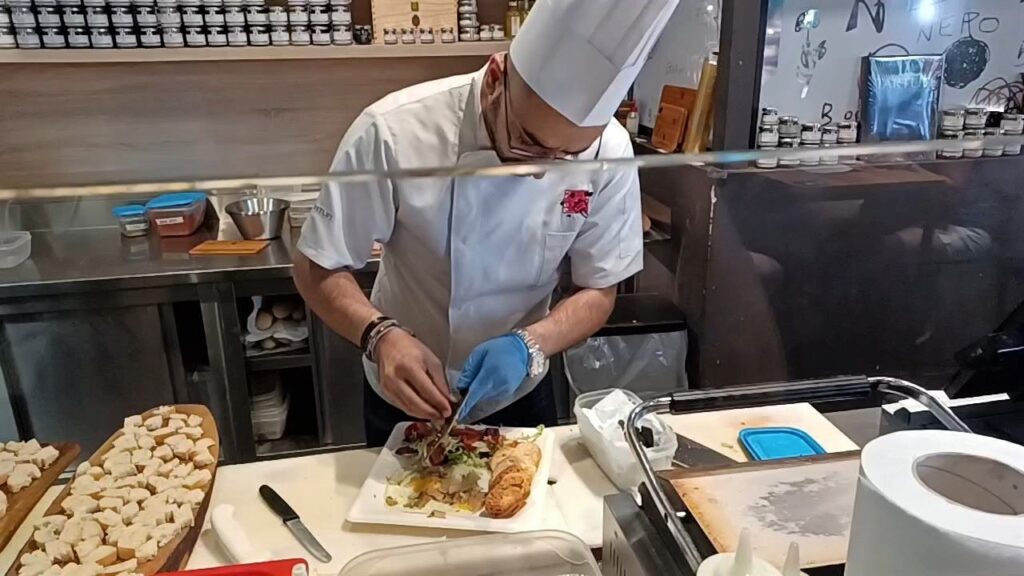
My favorite spot is Tartufo a restaurant by Luciano Savini. Luciano is the son of Zelindo, the founder of Savini Truffles, the famous truffle house in Tuscany.
Tartufo shaves fresh truffles on sunnyside up eggs, releasing their intoxicating aroma and flavor. Prices are reasonable for such a rare and decadent dish. I pair it with a nice glass of wine from Tannico, a nearby stall in the market.
Drinking in Milan
Wine
The Lombardy region is one of the smallest in Italy when it comes to wine production. In fact, it only produces one tenth of what comes out of Veneto. Franciacorta sparkling wine and red Valtellina are the main wines produced here and you’re sure to see them on wine lists in Milanese restaurants. But, since Milan is such a cosmopolitan city, glasses and bottles on offer often come from all over the country.
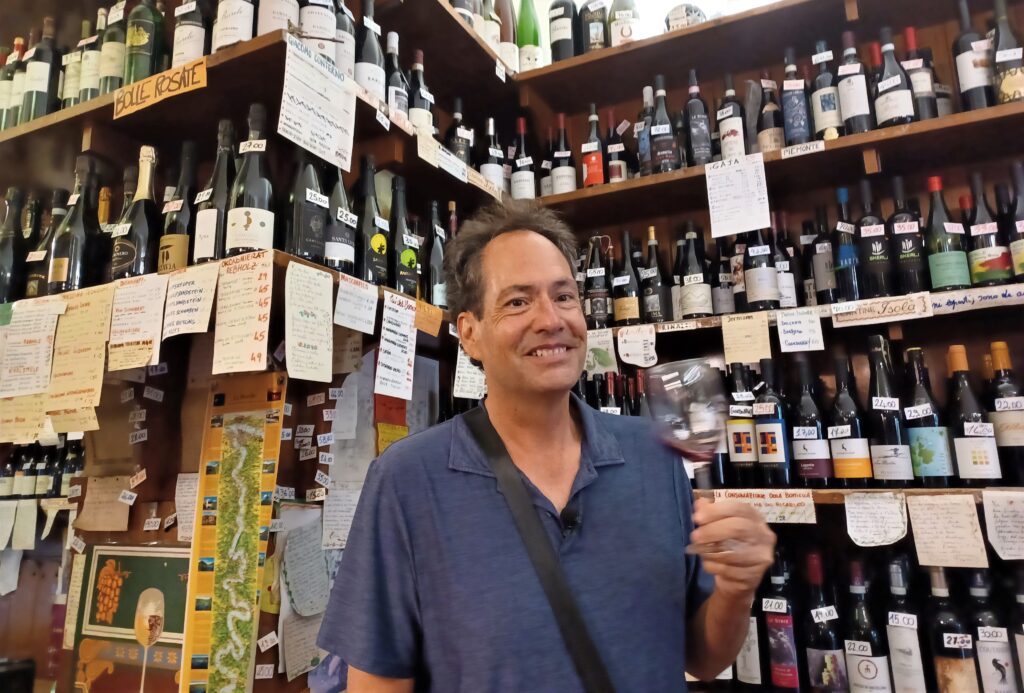
Cantine Isola dal 1896 is a terrific wine bar in the middle of Chinatown. They also have a nice bottle selection from not only Italy but all over Europe. Highly recommended.
Rovello 18 has a pan-Italian menu of very well made dishes. They also have an top-notch wine list.
Cocktails
It seems that cocktails and cocktail bars are more popular in Milan than wine and wine bars. Perhaps because Milan is a wealthy city, even young people can afford a relatively more expensive mixed drink (compared to wine or beer).
The Navigli neighborhood, once an industrial wasteland, is now a hip and overcrowded tourist destination filled with bars and restaurants that cater to the city’s visitors. While a lot of these places look like a rip-off, or at least overpriced, there are a few good spots, especially if you get off the main drag.
A few blocks away from the main tourist hub is Sacrestia Farmacia Alcolica, a former pharmacy that has been transformed into an ultra cool cocktail bar. They have a huge selection of mixed drinks that are well-prepared. There’s outdoor space to sit, but I like sitting in the dimly lit interior on the plush coaches.
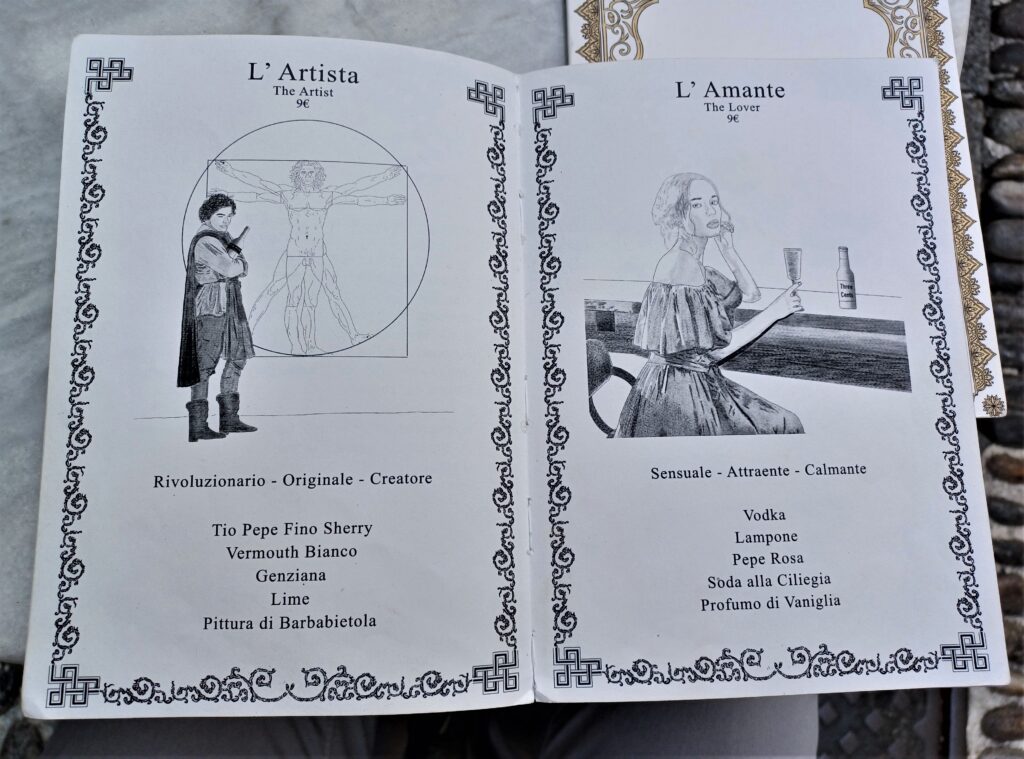
If you can’t make it out there, UGO is a bar just a block from the Naviglio Grande, They have a creative cocktail menu and they’re quite accommodating to all dietary restrictions (veg., vegan, gluten-free) with their aperitivo.
Negroni Sbagliato (Incorrect Negroni)
During a TV interview in 2022, actor Emma D’Arcy of HBO’s House of Dragon, talked about their favorite drink, Negroni Sbagliato, which translates to Incorrect Negroni. The cocktail originated at Bar Basso in the early 70’s by owner Mirko Stochetto. The story goes that Mirko was making a Negroni when he mistakenly grabbed a bottle or Prosecco instead of gin. Adding the Prosecco, he accidently made the first Negroni Sbagliato.
This story has been repeated all over social media to the point where it is accepted as gospel. However, it’s not the whole story.
Mirko’s son and current Bar Basso owner, Maurizio Stochetto says calling his father’s invention incorrect is, in itself, incorrect.
Maurizio says an employee had accidently placed a bottle of Prosecco where the gin should have been. His father grabbed what he thought was the gin bottle and immediately saw the mistake. However, since it was a beautiful day in Milan, Mirko thought “why not” and added the Prosecco instead of the gin.
So, it wasn’t a mistake in the sense that Mirko didn’t know what he was doing, instead, a happy coincidence caused him to try a new experiment which has become a legendary cocktail.
Bar Basso sells tons of Negroni Sbagliato in their fashionable bar and it’s a great place to get one. Their menu features lots of other cocktails they’ve invented including the Rossini, a spin on the Bellini made with Prosecco and strawberries.
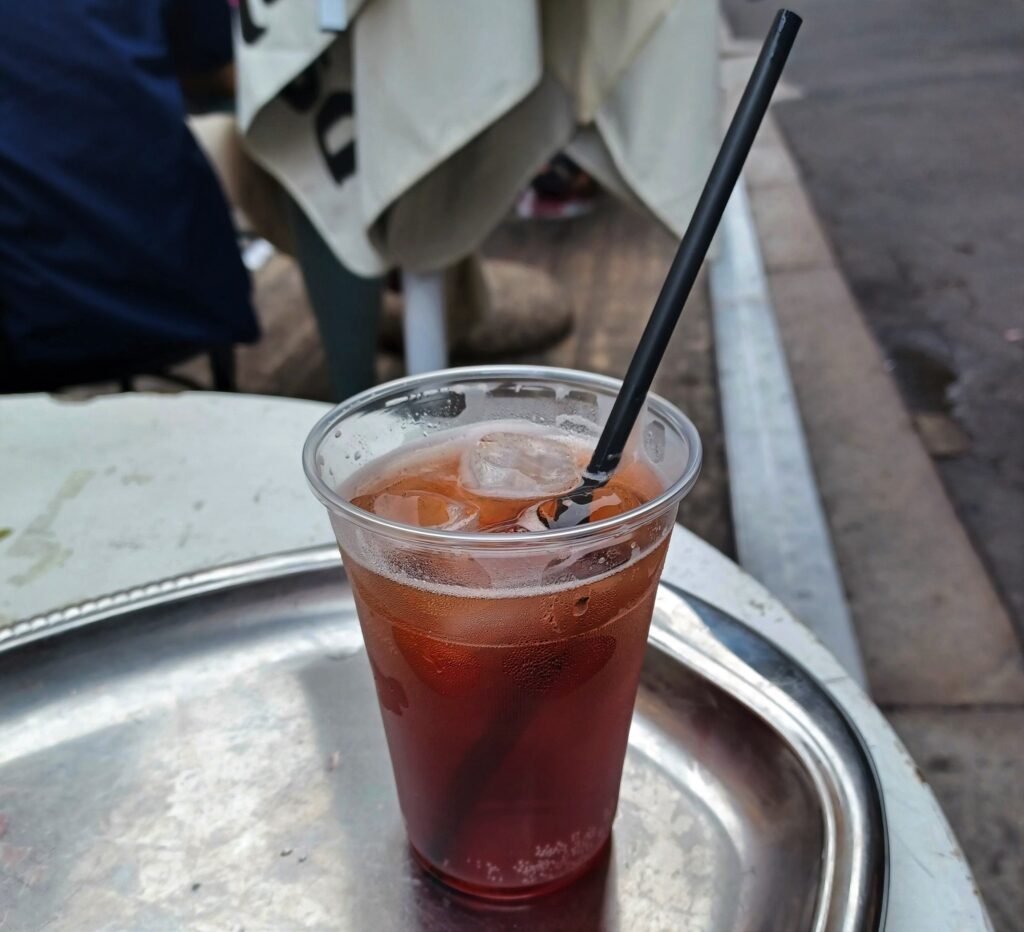
Bars all over Milan now offer Negroni Sbagliato. On the other end of the fashion spectrum is Bar Picchio, a hole in the wall in the bohemian, LGBT-friendly Venezia neighborhood. Bar Picchio has cheap and tasty Negroni Sbagliato served in a plastic cup. And, they’re right across the street from a terrific African restaurant, Warsa, serving delicious Eritrean cuisine.
Aperitivo
There was a time, before the pandemic, when Aperitivo in Milan meant shelling out €8-10 for a bitter drink like an Aperol Spritz or a Negroni and getting access to an all-you-can-eat buffet. Sounds great, right? Unfortunately, many of these buffets were filled with substandard food. Think about it, how much good food can you expect for ten euro? Certainly not a full buffet’s worth.
Then, the pandemic hit and in the name of public safety the buffets were shut. In their place, individual servings of food were provided with your drink for Aperitivo. Lots of this food was still of poor quality. However, many places have upgraded their Aperitivo game.
Most Aperitivo is served starting at 5 or 6pm and running to maybe 9. Sometimes it’s nothing more than a cup of olives or a little bowl of potato chips, just something to help absorb the alcohol. And, nowadays, it’s very common for places to not offer snacks for free. Instead, you’ll pay for what you order.
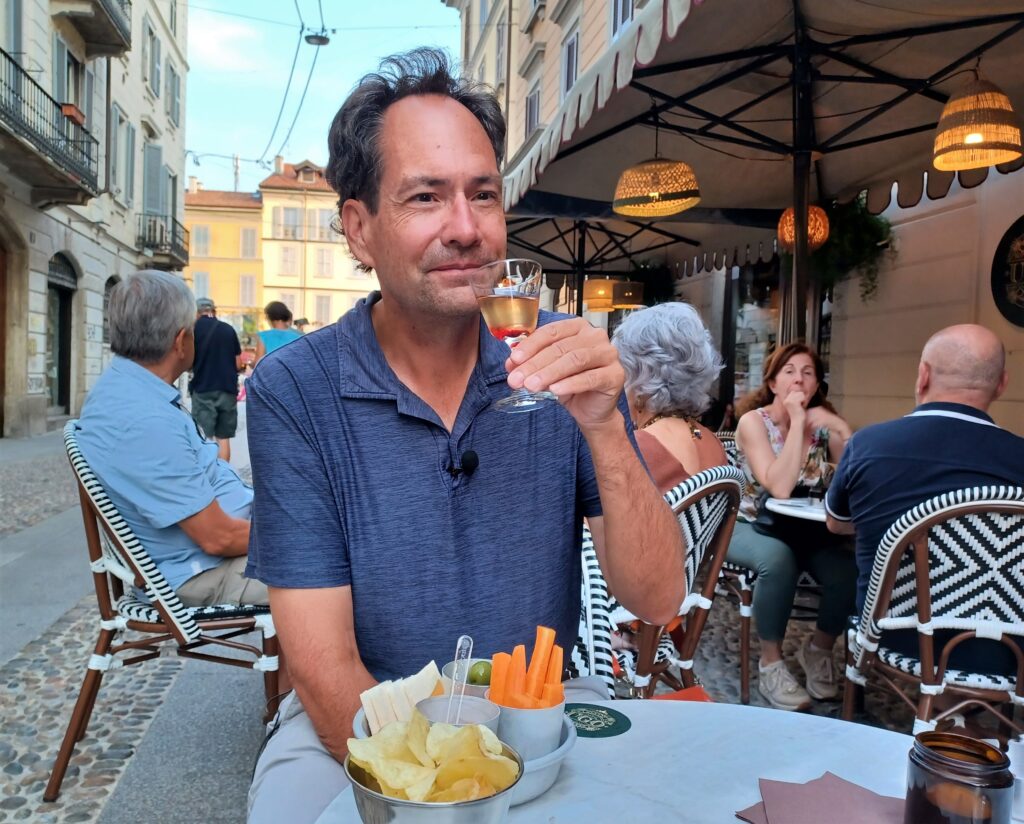
One spot I really like is UGO. They have a nice cocktail menu and yummy little plates of food. They’re quite accommodating to dietary restrictions, so if you’re vegan or gluten-free, this is a good spot for Aperitivo.
Morna is an offbeat bar with a good selection of wine and Aperitivo. What’s makes this place fun is that it’s right next to Bocciofila Montevideo, a social club with bocce courts. Sip on a glass of wine and watch the old guys play.
N’Ombra de Vin is a unique space with the bar in a 15th century wine cellar. Short but eclectic list of wines by the glass. There’s also a wine shop.
Barbajada
Cousin to Turin’s Bicerin, Barbajada is also a coffee-based drink. First popularized in Milan in the 19th century, Barbajada is made by adding frothy milk to espresso. Then cocoa or chocolate is added and the whole thing is topped with whipped cream.
The invention of the drink is credited to Milanese waiter Domenico Barbaja (thus the name) who supposedly created it in the early 1800’s. Barbaja became so successful that he opened a string of cafes serving his eponymous drink.
Domenico Barbaja had an interesting life away from the coffee houses. During the Napoleonic Wars he made another fortune as an arms dealer. Then, he became even more wealthy by running the gambling operations in the La Scala Opera House in Milan.
Barbaja parlayed his wealth into lofty positions managing theaters in Naples, Vienna and, later, La Scala itself. He commissioned operas by the likes of Bellini and von Weber. Barbaja even hired Rossini to write operas including Otello.
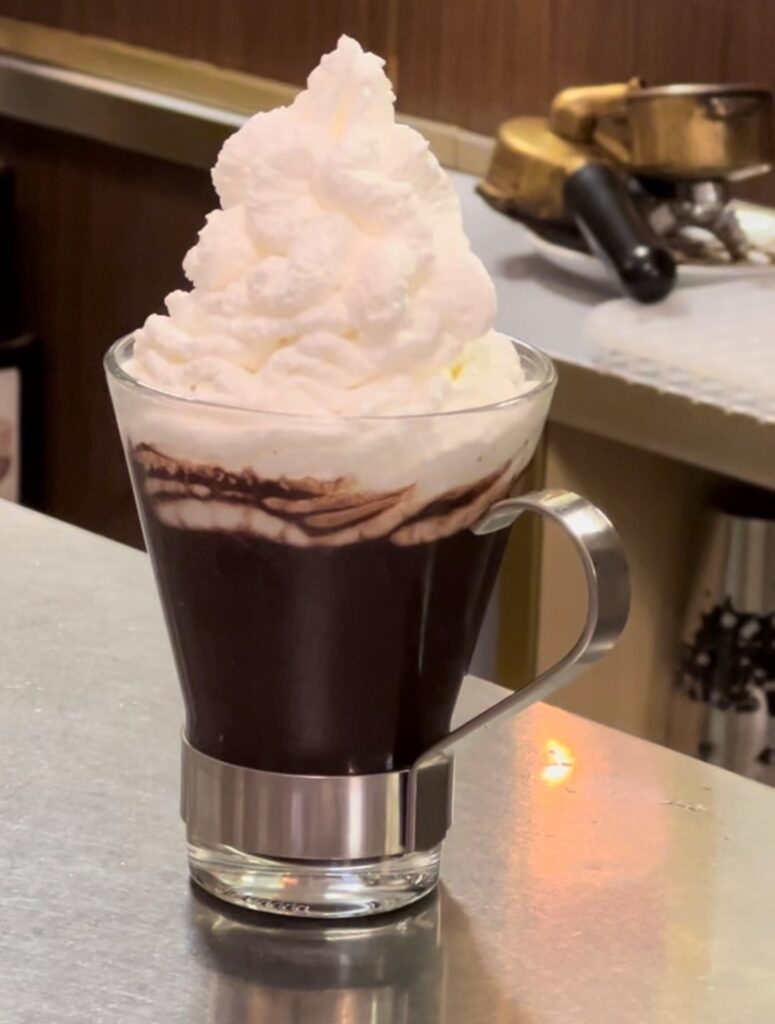
Wintertime is the best time to look for a Barbaja in Milan when cafes like Torrefazione Moka Hodeidah and Pavé serve the drink to take the chill off.
Things to do in Milan
Navigli
900 years ago, construction began on a series of canals (Navigli) in Milan, connecting the city to nearby rivers. These canals were used extensively for centuries to ship goods in and out of the city. Even the famous marble used on the Milan Cathedral arrived in the city via the Navigli.
But, by the 1930’s, the canals had outlived their purpose, and even though they continued to be used for some shipping, the canals were covered and mostly forgotten. When the port was decommissioned in the 1960’s it became a swamp and the neighborhood deteriorated.
Lately, however, the Navigli neighborhood has been revitalized thanks to the tourist industry. Barges run up and down the canals taking happy visitors on sightseeing tours. Dozens, maybe hundreds, of restaurants and bars have opened along the water and on the surrounding streets serving as many Aperol Spritz as tourists can drink.
In 2010, this would’ve been unimaginable, but today, Navigli is one of the busiest tourist areas of Milan. So much so that even walking around can feel claustrophobic, especially at night and on the weekend. While several bars and restaurants are interesting, many others look to be in existence strictly to separate tourists from their Euros.

One of my favorites in UGO, a hip bar a block from the canal. A quieter spot is Sacrestia Farmacia Alcolica, a few blocks away and removed from the tourist crush.
The Last Supper
Leonardo da Vinci spent some very productive time in Milan, arriving in 1482 for commission work. He painted two versions of “Virgin of the Rocks,” but neither resides in Milan. One sits in The Louvre, the other in Britain’s National Gallery.
During this time, Leonardo also painted his masterpiece “The Last Supper,” completing it in 1498. This incredible work makes giant leaps forward in the domain of perspective and movement.
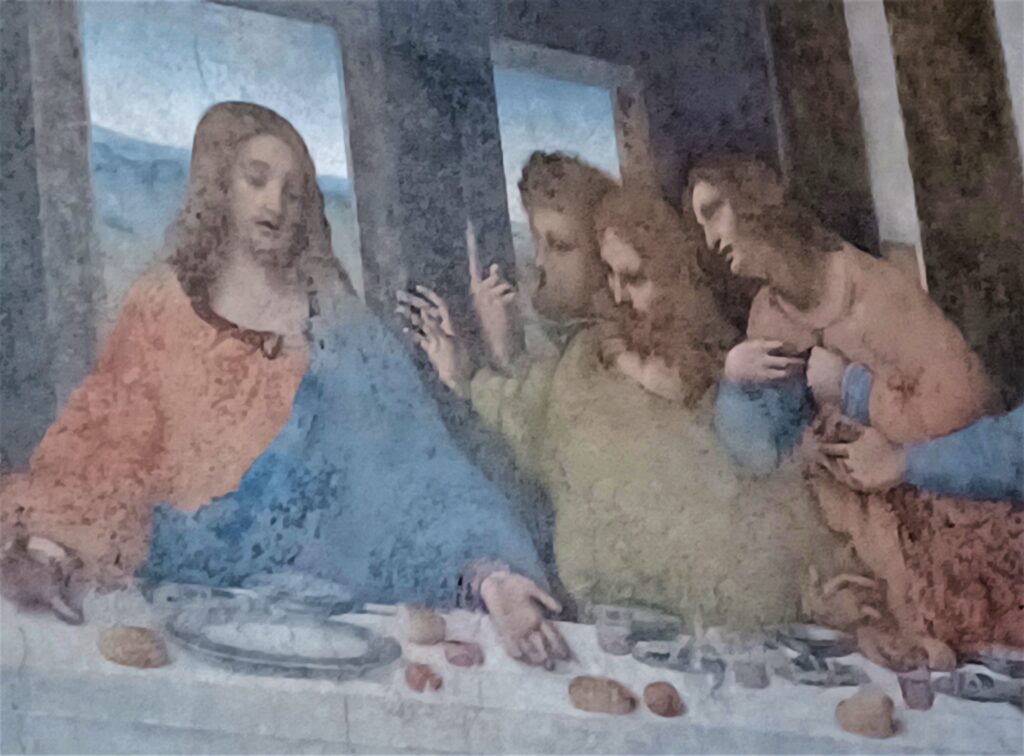
Normally, Leonardo would paint on canvas using oil-based paints. However, this job was to be completed on the wall of the dining area of the Santa Maria delle Grazie church. Instead of using the traditional methods of painting a fresco, da Vinci instead sealed the wall with paint and white lead and used tempera paint to allow the figures to have more vibrancy than a traditional fresco.
While this method may have worked in the short term, a few years after completion, significant deterioration was observed. Over the centuries, several restorations were attempted with varying degrees of success, although most, until the recent restoration that began in the 70’s, were deemed to be failures.
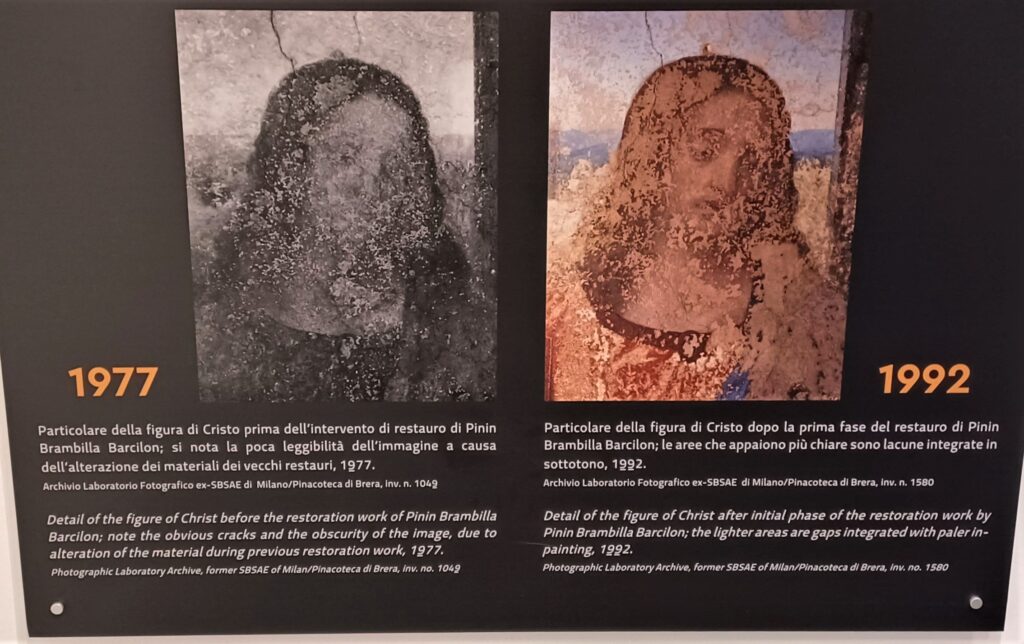
On August 15th, 1943, the Allies bombed Milan including the Santa Maria delle Grazie church. The Last Supper was undamaged leading some to call it a miracle, however, the church had done extensive work to protect the masterpiece prior to the bombing.
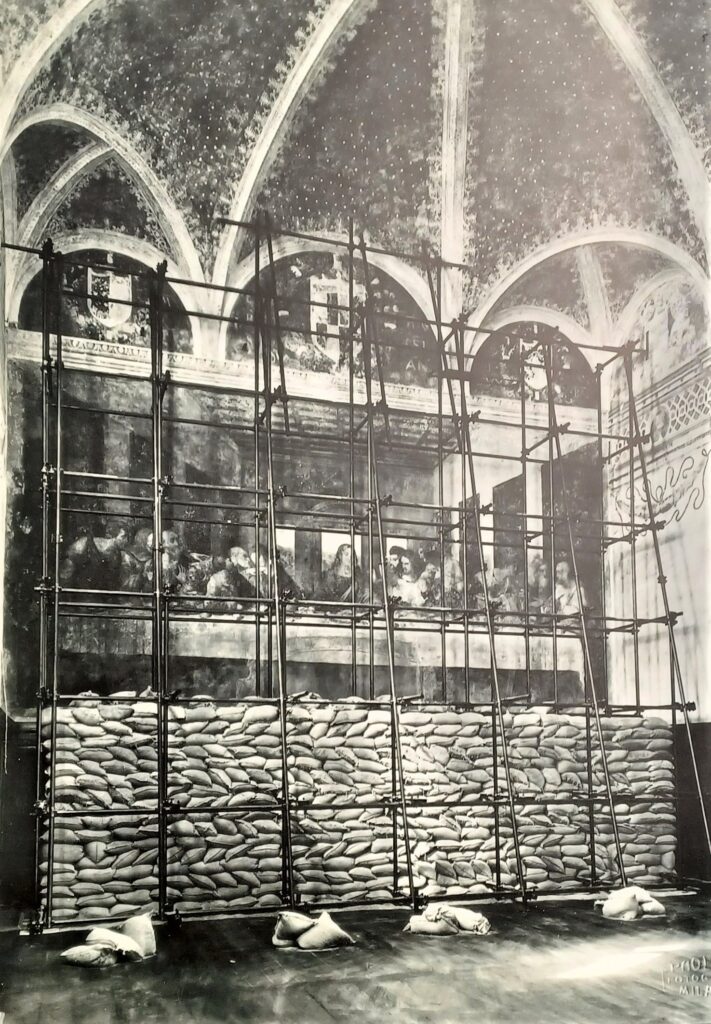
Visits to the church and the painting are tightly controlled and only a limited number of people are allowed to see The Last Supper each day because of its fragility. Because of this, demand is much larger than supply. So, it is best to book tickets weeks, if not a few months in advance. But, all the effort is worth it to see the painting that ushered in the Renaissance.
Duomo di Milano (Milan Cathedral)
Italy’s largest cathedral is the Duomo di Milano (St. Peter’s Basilica is in the independent State of Vatican City).
There has been a church on the site of the Duomo since 355 CE. Other churches were subsequently built on the site but in 1386, construction on the current Cathedral began. But, when the Duke of Milan died in 1402, building ground to a halt for nearly 100 years. Leonardo da Vinci submitted plans to complete the half-built cathedral in 1488 but later withdrew them.
The church wasn’t officially completed until 1965 when the final portal was done.

Lines to buy tickets to see the church can be long, but move along fairly quickly. You can also buy your tickets online. There are several options for tickets including one that includes an elevator ride to the roof.
While the church’s interior is impressive in it’s enormity, I really enjoyed the museum. Filled with tapestries and artifacts from the church as well as casts of statues of religious figures and gargoyles, it’s a can’t miss.
Tank tops are bare shoulders are not allowed in the Cathedral. Vendors outside will happily sell you a scarf to cover up or you can buy a plastic one from the vending machine inside the ticket office (yes, really). The website says shorts aren’t allowed either, but I saw dozens of people wearing them without coverage.
Other Churches
While the Duomo gets the lion’s share of visitors, there’s lots of other churches in Milan that have interesting architecture and jaw-dropping artwork.
Santuario di San Bernardino alle Ossa
In 417 CE, a church was built on this site, but a fire destroyed it in 1070. A new church was built in 1075. A new hospital, Ospedale del Brolo, was built nearby in the 13th century. Bodies from people who died at the hospital soon filled up the local graveyard and so a chamber connected to the church was built in 1210.
The bones of these poor souls, along with those of the monks who worked in the hospital as well as remains from inmates of the local prison are arranged in various patterns on the wall or just displayed behind some bars of steel in this Ossuary attached to the church. Legend has it that some of the bones are from Christian martyrs, but there is no evidence of that being the case. On the ceiling of the ossuary are interesting frescoes from the late 17th century.
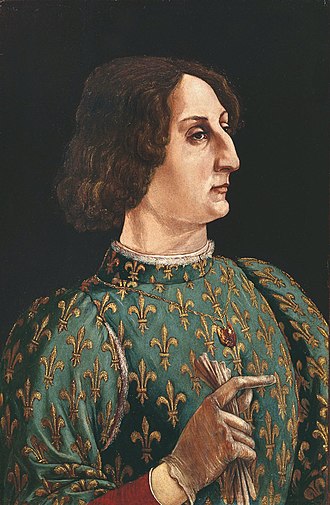
In 1476, three high ranking Milanese men plotted to kill Duke Galeazzo Maria Sforza. They were upset with the Duke for various transgressions including taking the virginity of one of the men’s sisters.
But, that wasn’t all of the Duke’s crimes. He was known to have raped many men and women. And, after completing the vile act, he handed the victims over to his Favorites for more violation.
Once, when an astrologer predicted the date of Sforza’s death, the Duke had him walled up and waited for him to starve. Another time, the Duke found a farmer had broken the law against rabbit hunting. He made the farmer swallow the rabbit whole which suffocated the man. Needless to say, Galeazzo Maria Sforza, was widely despised.
The plot to kill the Duke was carried out on in the Santuario di San Bernardino alle Ossa on December 26th, 1476, the feast day of St. Stephen. One of the men bowed before Sforza, rose suddenly, and repeatedly stabbed him. The others joined in and the Duke was killed.
Duke Galeazzo Maria Sforza was so hated that his corpse was taken by a mob and dragged through the streets while people kicked at it. The Duke’s body (now a beheaded corpse) was hung upside down outside one of the conspirator’s homes.
Two of the assassins were apprehended and executed. The third was killed by a guard in the church during the chaos after the murder.
Chiesa di San Maurizio
First built as a Benedictine Monastery in the 8th or 9th century, Chiesa di San Maurizio was rebuilt in the early 16th century.
The church is filled with magnificent frescoes commissioned by Ippolita Sforza because her daughter was a nun there. While there are dozens of spectacular frescoes in the church, one of the most interesting is a depiction of Noah’s Arc complete with unicorns boarding the boat!
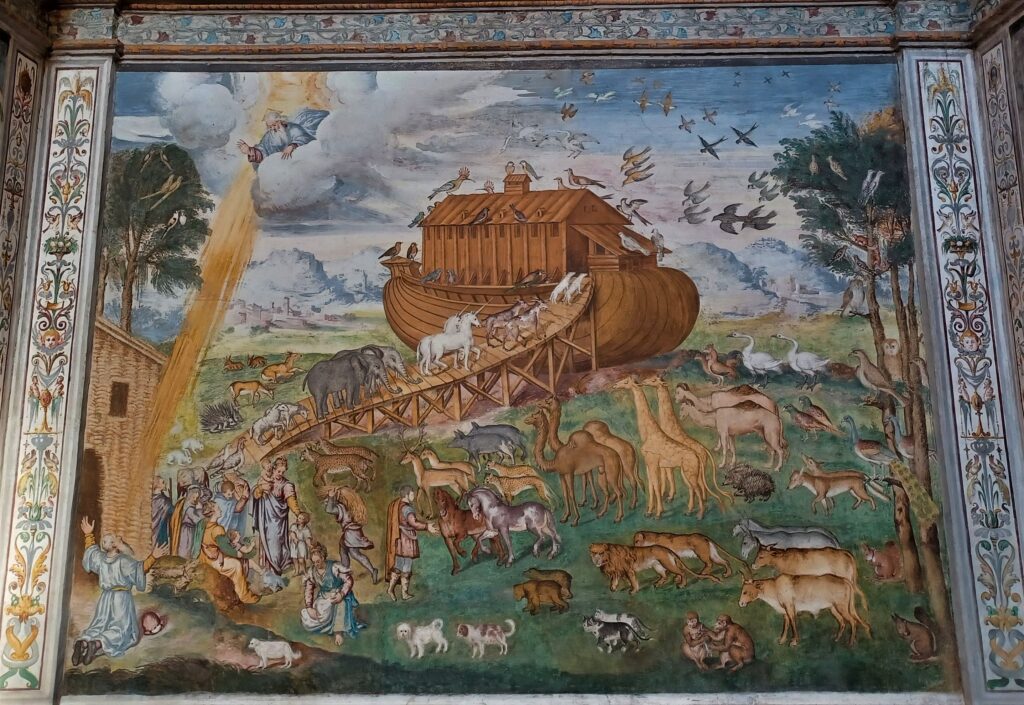
San Vittore al Corpo
Most people come to this site for the Museo Nazionale Scienza e Tecnologia Leonardo da Vinci (Leonardo da Vinci Museum of Science and Technology), a good spot to see the plans, drawings, and prototypes of some of da Vinci’s most famous inventions. The museum is in part of the San Vittore al Corpo Monastery.
However, this church itself, which is free to enter and is not part of the museum, is also quite interesting. Originally a Roman mausoleum, the church was built in the 4th century. In the 8th century the church was expanded when it was gifted the relics (remains) of Saint Vittore and Saint Satiro. In the Middle Ages, relics were a kind of tourist attraction. Pilgrims would come from all over the continent to see the relics and pray. The more important the saint, the more pilgrims and and the richer the church would get. So, getting the remains of a saint like Vittore was a big deal for the church.
In the 16th century, the church was reconstructed and during the Napoleonic occupation it was used as a military hospital. The church was damaged in 1943 when the Allies bombed Milan.
Inside the church is a dome decorated with paintings by Guglielmo Caccia (aka il Moncalvo) and his student Daniele Crespi. Eighty panels depict figures rising higher and higher to the peak of the dome which looks like open sky. Quite striking.

Chiesa Santa Maria delle Grazie
The second most famous church in Milan because da Vinci’s masterpiece “The Last Supper” is painted on a wall in the former dining room. Be sure to book tickets well in advance.
Teatro alla Scala
Milan’s opera house, the Teatro alla Scala, might be the most famous theater in the world. Virtually every major operatic singer has performed here from Enrico Caruso to Maria Callas to Luciano Pavarotti. Verdi debuted his opera Otello as well as his final work Falstaff. Giacomo Puccini’s Turandot also premiered at La Scala. And that’s just a small sampling!
After a fire destroyed the Teatro Regio Ducale in Milan in 1776 a new performance center, The Teatro alla Scala, was completed in 1778 on the site of a deconsecrated and demolished church, the Santa Maria alla Scala.
Originally, the floor had no seats or orchestra pit. There was also a casino with gambling in the foyer which, according to legend, would sometimes spill into the auditorium which must’ve made for a raucous atmosphere.
While the boxes (suites) were expensive and reserved for Milan’s wealthy, the upper levels, called the Loggione, was less expensive and the seats were populated with the so-called Loggionisti, a group of working class patrons who were nonetheless quite sophisticated in their appreciation of opera. The Loggionisti were also very quick to voice their displeasure with what they felt were substandard performances. Believe it or not, Maria Callas and Luciano Pavarotti were actually booed at La Scala. One performer was jeered so forcefully that he left the stage mid-performance, forcing his understudy to take the stage before he could even get into costume!
The performance season at La Scala runs through the winter and tickets are quite expensive. However, to get an up-close look at the theater, you can buy a ticket to the museum which includes a peek inside the space.
The museum itself is quite interesting, as well. There are posters, costumes, and artifacts from performances as well as paintings and busts of some of the most famous singers, composers, and conductors to have worked at La Scala.
There are also interesting temporary exhibits in the museum.
Poldi Pezzoli Museum

Gian Giacomo Poldi Pezzoli was a 19th century Count who was born into a very wealthy Milanese family. Pezzoli’s lot in life allowed him to collect artwork (mostly Renaissance), glasswork, ceramics, and other rare and expensive items.
Pezzoli spent the last quarter century of his life renovating the palace to allow for this display of his mammoth collection which he intended to be on display for the people of Milan after he died. In 1881, two years after his death, the Poldi Pezzoli Museum opened.
You can wander through the rooms and admire the works. Especially notable is Sandro Botticelli’s Lamentation over the Dead Christ and Piero del Pollaiuolo’s Portrait of a Young Woman.
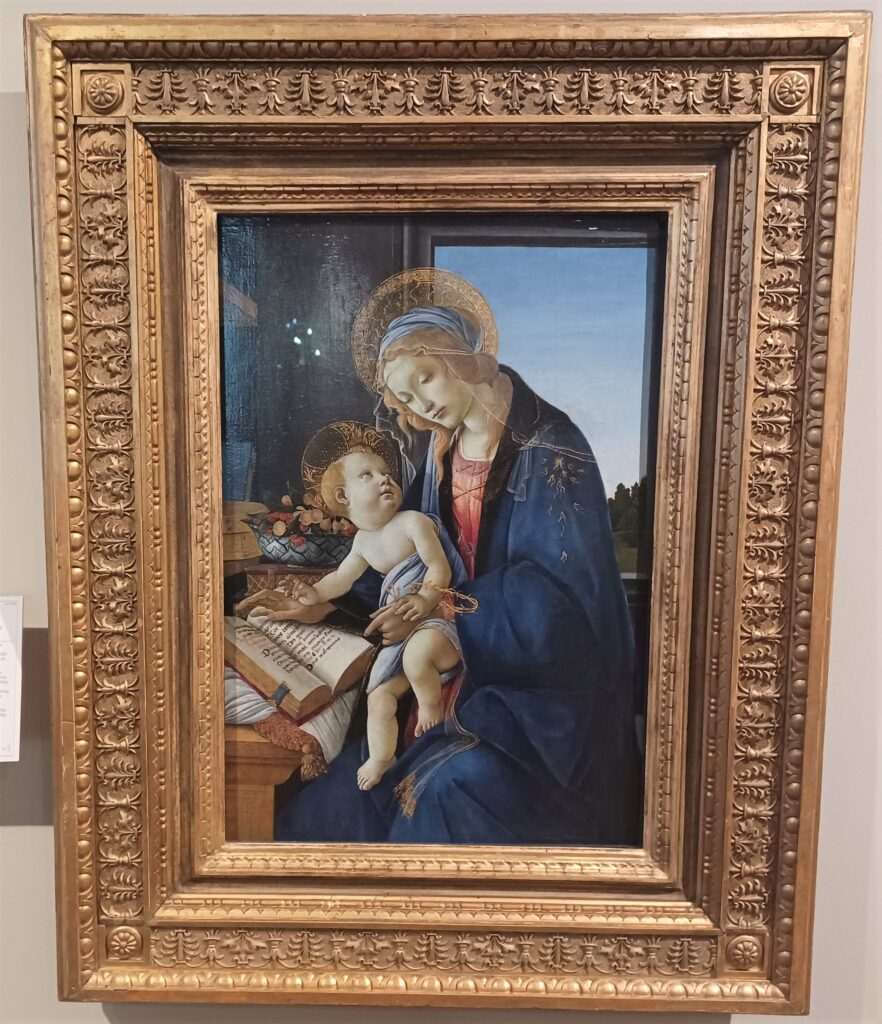
Monumental Cemetery of Milan
The Monumental Cemetery of Milan opened in 1866 with the intention of consolidating several smaller, scattershot graveyards in the city. It has become one of the most stunning cemeteries in Italy with the many statues, obelisks, and monuments. All the haunting imagery reminds me of a Gothic cemetery from the southern United States.
Not surprisingly, the most impressive markers are for the wealthiest Milanese. Industrialist Antonio Bernocchi’s mausoleum depicts the Tower of Babel decorated with sculptures of the stations of the cross. The tomb of the Campari family (yes, the bitter liquor magnates) is topped with a Last Supper sculpture.
The Famedio section is a kind of hall of fame of famous dead Italians. There are markers for people like Giuseppe Verdi, who isn’t even buried there, and poet/novelist Alessandro Manzoni, who is.
There is also a Jewish area to the cemetery with a separate entrance that opened in 1872. Some of the markers honor Milan’s Jewish people killed by the Nazis in concentration camps.
Transportation
Milan Malpensa Airport
Busiest of Milan’s major airports with the most worldwide nonstop flights including North America.
21010 Ferno, Province of Varese, Italy
Ground Transportation
There is a convenient train to and from the airport. Bus is an alternative. Taxis and Uber Black (no regular Uber) are available, but expensive.
Milan Bergamo Airport
Non stop flights to many European cities and a few in the Middle East and north Africa.
24050 Province of Bergamo, Italy
Ground Transportation
There are several bus companies servicing the airport from Milan at reasonable prices. Uber Black and Taxi are very expensive alternatives. There is no train service to the airport, but there is a train station in the town of Bergamo that has service to Milan. From the Bergamo train station it’s a taxi ride costing about €30.
Linate Airport
The smallest of Milan’s 3 major airports. Nonstop flights to many European cities but none to North America.
Viale Enrico Forlanini, 20054 Segrate MI, Italy
Ground Transportation
Even though Linate is the smallest of the 3 major Milan airports and has the fewest connections, it has the easiest transport into the city. The M4 Metro line takes you to the city center in 12 minutes. There are also several companies offering bus service to Milan. The S6 light rail line is another option.
Taxis and Uber Black are the most expensive ways to get to the city.
Local Transportation
Milan is a big city with lots to see and do. If you utilize the excellent mass transit system, you’ll be able to see a lot more and be less tired.
The Milan Metro is world class and connects much of the city. You can buy tickets from kiosk or (if they happen to be open) an agent desk. There is also a network of trams and light rail called the Overland Lines. Buses are everywhere as well.
Uber, as such, is not available in Italy. Instead, some cities have Uber Black, a much more expensive version of Uber with nicer cars.
There are several bike sharing companies in Milan and most of them have terrible reputations. BikeMi is the best of the lot, I guess, but even then I wouldn’t want to ride a bike on Milan’s bumpy and crowded streets.
Index of Things to do in Milan
A Signorina in Milan
Great food-focused blog about Milan. Private food tours, too.
Last Supper Museum
Former church houses Leonardo da Vinci’s masterpiece. Book tickets well in advance.
Piazza di Santa Maria delle Grazie, 20123 Milano MI, Italy
Duomo di Milano
Massive church took 600 years to complete.
P.za del Duomo, 20122 Milano MI, Italy
Teatro alla Scala
One of the most famous opera houses in the world. There’s an interesting museum on site.
Via Filodrammatici, 2, 20121 Milano MI, Italy
Statua di Leonardo da Vinci
Statue of Leonardo in the tiny park across the street from the Teatro alla Scala.
Piazza della Scala, 20121 Milano MI, Italy
Poldi Pezzoli Museum
Museum with lots of Renaissance paintings including two by Botticelli.
Via Alessandro Manzoni, 12, 20121 Milano MI, Italy
Leonardo da Vinci Museum of Science and Technology
Museum featuring several of Leo’s machines brought to life from his sketches.
Via San Vittore, 21, 20123 Milano MI, Italy
Sforzesco Castle
Castle and museum with a Michelangelo sculpture.
Piazza Castello, 20121 Milano MI, Italy
Parco Semipone
Park surrounding the Sforzesco Castle.
Piazza Sempione, 20154 Milano MI, Italy
Pinacoteca di Brera
Art gallery with many famous works including Rafael.
Via Brera, 28, 20121 Milano MI, Italy
Brera Botanical Garden
Botanical garden in the hip Brera neighborhood.
Via Brera, 28, 20121 Milano MI, Italy
Basilica di San Vittore al Corpo
Church with frescoes and dome.
Via San Vittore, 25, 20122 Milano MI, Italy
Santuario di San Bernardino alle Ossa
Church with ossuary.
Piazza Santo Stefano, 20122 Milano MI, Italy
Basilica di Sant’Ambrogio
One of the oldest churches in Milan. Consecrated in 379.
Piazza Sant’Ambrogio, 15, 20123 Milano MI, Italy
Basilica di Sant’ Eustorgio
Church with nice frescoes.
Piazza Sant’Eustorgio, 1, 20122 Milano MI, Italy
Chiesa di San Maurizio al Monastero Maggiore
More excellent frescoes.
Corso Magenta, 15, 20123 Milano MI, Italy
Navilglo Grande
Largest canal in Milan. Lined with bars and restaurants.
Alzaia Naviglio Grande, 160, 20144 Milano MI, Italy
Monumental Cemetery of Milan
Cemetery with incredible statuary and markers.
Piazzale Cimitero Monumentale, 20154 Milano MI, Italy
Palazzo Reale di Milano
Royal Palace is now a cultural center with exhibits.
P.za del Duomo, 12, 20122 Milano MI, Italy
Ambrosian Library
Historic art gallery and library.
Piazza Pio XI, 2, 20123 Milano MI, Italy
Bosco Verticale
Housing development with a living, green facade.
Via Gaetano de Castillia, 11, 20124 Milano MI, Italy
San Gottardo
Octagonal bell tower.
Corso S. Gottardo, 20136 Milano MI, Italy
Villa Necchi Campiglio
Elegant mansion/museum.
Via Mozart, 14, 20122 Milano MI, Italy
Index of Food & Drink in Milan
Rovello 18
Excellent restaurant with an outstanding wine list.
Via Tivoli, 2, 20121 Milano MI, Italy
Mercato Centrale
Food hall with several excellent choices like Tartufo and Tannico. Inside the train station.
Via Giovanni Battista Sammartini, 2, 20125 Milano MI, Italy
Linfa Milano
Vegan restaurant.
Via Bergognone, 24, 20144 Milano MI, Italy
L’Isola del Tesoro
Down home restaurant featuring Sardinian cuisine.
Via Ludovico da Viadana, 2, 20122 Milano MI, Italy
Ratana
Excellent restaurant with a small garden used for some dishes.
Via Gaetano de Castillia, 28, 20124 Milano MI, Italy
VegAmore
Vegan cafe with vegan tiramisu.
Via Crema, 12, 20135 Milano MI, Italy
Joia
High end veg. restaurant. Also has a less expensive bistro.
Via Panfilo Castaldi, 18, 20124 Milano MI, Italy
Veganfruttariano – Sound of ’70s
Vegan restaurant.
Via Ignazio Ciaia, 4, 20158 Milano MI, Italy
Warsa Restaurant
Eritrean restaurant.
Via Melzo, 16, 20129 Milano MI, Italy
Meze
Lebanese restaurant.
Via Pasquale Sottocorno, 19, 20129 Milano MI, Italy
MU dimsum
Dim sum restaurant with veggie Bao.
Via Aminto Caretto, 3, 20124 Milano MI, Italy
Bon Wei
Michelin recognized Chinese restaurant.
Via Lodovico Castelvetro, 16/18, 20154 Milano MI, Italy
Gino Sorbillo’s
Naples famous pizzeria comes to Milan.
Via Pietro Borsieri, 25, 20159 Milano MI, Italy
Dry
One of the best pizza joints in Milan.
Via Solferino, 33, 20121 Milano MI, Italy
Masu
Filipino restaurant.
Viale Stelvio, 72, 20159 Milano MI, Italy
Il Salumaio di Montenapoleone
Bistro with aperitivo.
Via Santo Spirito, 10, 20121 Milano MI, Italy
Un Posto a Milano
Rustic farmhouse restaurant with vegan options.
Via Privata Cuccagna, 2/4, 20135 Milano MI, Italy
Sidewalk Kitchens
Open air food court.
Via Bonvesin de la Riva, 3, 20129 Milano MI, Italy
Sweets Namura
Excellent bakery.
Via Lodovico Castelvetro, 16, 20154 Milano MI, Italy
Torrefazione Moka Hodeidah
Outstanding coffee shop serves Barbajada in winter.
Via Piero della Francesca, 8, 20154 Milano MI, Italy
Marchesi 1824
One of the best bakeries in Milan.
Via Santa Maria alla Porta, 11/a, 20123 Milano MI, Italy
Zaini Milano
Chocolate cafe.
GluFree Bakery
Top notch gluten free bread, pastry, pizzettes and more.
Via Curtatone, 6, 20122 Milano MI, Italy
Martesana Pastry Shop
Bakery and coffee shop.
Via Paolo Sarpi, 62, 20154 Milano MI, Italy
Pavé
Bakery and breakfast spot with Barbajada in season.
Via Felice Casati, 27, 20124 Milano MI, Italy
Vergani Milano
Pastry shop with Barbajada in season.
Via Saverio Mercadante, 17, 20124 Milano MI, Italy
Panarello
Bakery with good Cannoncini.
Via Speronari, 3, 20123 Milano MI, Italy
Panzerotti Luni
Bakery with Panzerotti, little turnovers with savory fillings.
Via Santa Radegonda, 16, 20121 Milano MI, Italy
Tone Milano Bread Lab
Bakery with a Georgian bread oven serving an Italian riff on Khachapuri.
Via Donatello, 22, 20131 Milano MI, Italy
Gelateria Paganelli
Excellent gelateria has been open since the 1930’s.
Via Adda, 3, 20124 Milano MI, Italy
Cerdini & Quenardei dal 1906
Excellent gelato and some sorbetto made with champagne.
Via Cusani, 10, 20121 Milano MI, Italy
Antica Gelateria Sartori
Gelato cart next to the train station has been open since 1937.
Piazza Luigi di Savoia, 20125 Milano MI, Italy
Terra Gelato
Gelateria featuring DOP & PGI ingredients.
Via Vitruvio, 38, 20124 Milano MI, Italy
Ciacco
Artisan gelato.
Via Spadari, 13, 20123 Milano MI, Italy
[LA] Gelateria della Musica
Gelateria with a music theme.
Via Lodovico Il Moro, 3, 20143 Milano MI, Italy
Avgvsto Premiata Gelateria
Small batch gelateria with vegan options.
Viale Coni Zugna, 54, 20144 Milano MI, Italy
Crema Alta Gelateria
Gelateria
Gelato Giusto
Concord grape gelato when in season.
Via S. Gregorio, 17, 20124 Milano MI, Italy
LatteNeve
Gelateria with vegan and gluten free options.
Via Vigevano, 27, 20144 Milano MI, Italy
Enrico Rizzi
Gelato shop with unusual gelato combinations. Bakery, too.
Via Cesare Correnti, 5, 20123 Milano MI, Italy
Antico Gelateria Tradizionale
Gelato shop.
Via Dogana, 1, 20123 Milano MI, Italy
Gelateria Solferino
Gelato shop.
Via Solferino, 18, 20121 Milano MI, Italy
Sioli and Bissoli Gelateria
Gelato shop.
Via Lodovico Muratori, 26, 20135 Milano MI, Italy
Cantine Isola dal 1896
Terrific bar with a great wine selection in Chinatown.
Via Paolo Sarpi, 30, 20154 Milano MI, Italy
Sacrestia Farmacia Alcolica
Super cool bar away from the crush in Navigli.
Via Conchetta, 20, 20136 Milano MI, Italy
oTTo
Cool bar on the edge of Chinatown.
Via Paolo Sarpi, 10, 20154 Milano MI, Italy
UGO
Cocktail bar in Navigli. Vegan and gluten free aperitivo options.
Via Corsico, 12, 20144 Milano MI, Italy
Bar Picchio
Old school bar with cheap Negroni Sbagilato.
Via Melzo, 11, 20129 Milano MI, Italy
Bar Basso
Bar where Negroni Sbagilato was invented.
Via Plinio, 39, 20133 Milano MI, Italy
Bar Luce
Bar designed my movie director Wes Anderson.
L.go Isarco, 2, 20139 Milano MI, Italy
N’Ombra de Vin
Wine bar with a 15th century cellar.
Via S. Marco, 2, 20121 Milano MI, Italy
Morgan’s
Dive bar with simple aperitivo.
Via Francesco Novati, 02, 20123 Milano MI, Italy
Mag
Old timey bar with inventive cocktails.
Ripa di Porta Ticinese, 43, 20143 Milano MI, Italy
Morna
Cocktail bar with bocce.
Via Tortona, 21, 20144 Milano MI, Italy
Index of Shopping in Milan
La Baita del Formaggio
Cheese shop been around since 1958.
Via Vincenzo Foppa, 5, 20144 Milano MI, Italy
Peck
Gourmet grocer and prepared food.
Via Spadari, 9, 20123 Milano MI, Italy
Rinascente Milano
High end grocer with lots of good prepared foods and a couple restaurants.
P.za del Duomo, 20121 Milano MI, Italy
Drogheria Colonna
Old-school Milanese grocery store.
Via Eugenio Villoresi, 02, 20143 Milano MI, Italy
Drogheria Grossi
Traditional grocer.
Corso Magenta, 31, 20123 Milano MI, Italy
Eataly
Famous Italian upscale grocer has a location in Milan.
Piazza Venticinque Aprile, 10, 20121 Milano MI, Italy
Soggettiva Gallery
Alternative movie posters.
Via Pasquale Sottocorno, 5/A, 20129 Milano MI, Italy
Enoteca perBacco Vino Sfuso di Adriano Franzolin
Wine shop with bottles and wine in bulk.
Via Giuseppe Pecchio, 4, 20131 Milano MI, Italy
Ambroeus
Vintage clothing.
Via Pastrengo, 15, 20159 Milano MI, Italy
Vintage Delirium
Vintage clothing store.
Via Giuseppe Sacchi, 3, 20121 Milano MI, Italy
Live in Vintage
Vintage clothing store.
Via Genova Thaon di Revel, 4, 20159 Milano MI, Italy
Galleria Vittorio Emanuele II
Large shopping center with famous fashion brands.
P.za del Duomo, 20123 Milano MI, Italy
Index of Places to Stay in Milan
Hotel Crivi’s
Nice, traditional Italian hotel with a free, full breakfast.
Corso di Porta Vigentina, 46, 20122 Milano MI, Italy
43 Station Hotel
Stylish 3 star hotel near the Centrale train station.
Via Fabio Filzi, 43, 20124 Milano MI, Italy
Antica Locanda dei Mercanti
Boutique hotel in 18th century townhouse.
Via S. Tomaso, 6, 20121 Milano MI, Italy
Hotel nhow Milano
4 star hotel in the Navigli neighborhood.
Via Tortona, 35, 20144 Milano MI, Italy
About the Author

Brent Petersen is the Editor-in-Chief of Destination Eat Drink. He currently resides in Setubal, Portugal. Brent has written the novel “Truffle Hunt” (Eckhartz Press) and the short story collection “That Bird.” He’s also written dozens of foodie travel guides to cities around the world on Destination Eat Drink, including in-depth eating and drinking guides to the Cinque Terre, Amalfi Coast, Naples, Palermo, Turin, and Ortigia in Italy. Brent’s podcast, also called Destination Eat Drink, is available on all major podcasting platforms.

